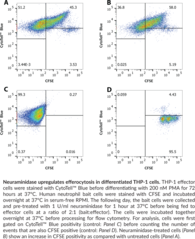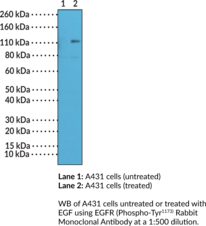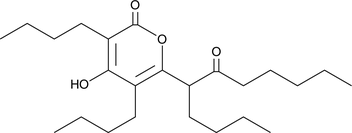Cayman
Showing 19351–19500 of 45550 results
-
Terminally misfolded proteins, recognized by chaperones on the endoplasmic reticulum (ER), are transported to depots for ubiquitination and proteasomal degradation by the ER-associated protein degradation (ERAD) pathway. Eeyarestatin 1 is an inhibitor of the ERAD pathway, blocking the degradation of misfolded proteins at a dose of 8 µM.{15691} It associates with the p97-associated deubiquitinating complex in cells, preventing deubiquitination of substrates by ataxin-3.{27313,27314} Eeyarestatin 1, at 4 µM, interferes with both retrograde and anterograde trafficking of proteins, including certain toxins, and potentially, viruses.{27315}
Brand:CaymanSKU:10012609 - 10 mgAvailable on backorder
-
Terminally misfolded proteins, recognized by chaperones on the endoplasmic reticulum (ER), are transported to depots for ubiquitination and proteasomal degradation by the ER-associated protein degradation (ERAD) pathway. Eeyarestatin 1 is an inhibitor of the ERAD pathway, blocking the degradation of misfolded proteins at a dose of 8 µM.{15691} It associates with the p97-associated deubiquitinating complex in cells, preventing deubiquitination of substrates by ataxin-3.{27313,27314} Eeyarestatin 1, at 4 µM, interferes with both retrograde and anterograde trafficking of proteins, including certain toxins, and potentially, viruses.{27315}
Brand:CaymanSKU:10012609 - 25 mgAvailable on backorder
-
Terminally misfolded proteins, recognized by chaperones on the endoplasmic reticulum (ER), are transported to depots for ubiquitination and proteasomal degradation by the ER-associated protein degradation (ERAD) pathway. Eeyarestatin 1 is an inhibitor of the ERAD pathway, blocking the degradation of misfolded proteins at a dose of 8 µM.{15691} It associates with the p97-associated deubiquitinating complex in cells, preventing deubiquitination of substrates by ataxin-3.{27313,27314} Eeyarestatin 1, at 4 µM, interferes with both retrograde and anterograde trafficking of proteins, including certain toxins, and potentially, viruses.{27315}
Brand:CaymanSKU:10012609 - 5 mgAvailable on backorder
-
Efaproxiral is an allosteric hemoglobin (Hb) modifier that reduces the affinity of Hb for oxygen, increasing the diffusion of oxygen from blood to tissue.{51161} In isolated human whole blood, efaproxiral (1.75 mM) increases the partial pressure of oxygen at which Hb is 50% saturated (p50) from 26.75 to 38.63 mm Hg and decreases the percent oxyhemoglobin (Hb-O2) saturation from 48 to 33.8% at a partial oxygen pressure (pO2) of 26 mm Hg. Efaproxiral (150 mg/kg) increases tumor pO2 from 5.2 to 13.1 mm Hg 30 minutes after administration in a RIF-1 mouse fibrosarcoma flank tumor model.{51162} Efaproxiral (100 μM) enhances radiation-induced cytotoxicity in EMT6 mouse breast cancer cells grown under hypoxic conditions and increases radiosensitization and inhibits tumor growth in a hypoxic Lewis lung tumor mouse model when administered at a dose of 100 mg/kg.{51163} It also increases the running capacity of normal mice and mice with left coronary artery (LCA) ligation-induced myocardial infarction (MI) when administered at a dose of 150 mg/kg.{51164}
Brand:CaymanSKU:28294 - 1 gAvailable on backorder
-
Efaproxiral is an allosteric hemoglobin (Hb) modifier that reduces the affinity of Hb for oxygen, increasing the diffusion of oxygen from blood to tissue.{51161} In isolated human whole blood, efaproxiral (1.75 mM) increases the partial pressure of oxygen at which Hb is 50% saturated (p50) from 26.75 to 38.63 mm Hg and decreases the percent oxyhemoglobin (Hb-O2) saturation from 48 to 33.8% at a partial oxygen pressure (pO2) of 26 mm Hg. Efaproxiral (150 mg/kg) increases tumor pO2 from 5.2 to 13.1 mm Hg 30 minutes after administration in a RIF-1 mouse fibrosarcoma flank tumor model.{51162} Efaproxiral (100 μM) enhances radiation-induced cytotoxicity in EMT6 mouse breast cancer cells grown under hypoxic conditions and increases radiosensitization and inhibits tumor growth in a hypoxic Lewis lung tumor mouse model when administered at a dose of 100 mg/kg.{51163} It also increases the running capacity of normal mice and mice with left coronary artery (LCA) ligation-induced myocardial infarction (MI) when administered at a dose of 150 mg/kg.{51164}
Brand:CaymanSKU:28294 - 100 mgAvailable on backorder
-
Efaproxiral is an allosteric hemoglobin (Hb) modifier that reduces the affinity of Hb for oxygen, increasing the diffusion of oxygen from blood to tissue.{51161} In isolated human whole blood, efaproxiral (1.75 mM) increases the partial pressure of oxygen at which Hb is 50% saturated (p50) from 26.75 to 38.63 mm Hg and decreases the percent oxyhemoglobin (Hb-O2) saturation from 48 to 33.8% at a partial oxygen pressure (pO2) of 26 mm Hg. Efaproxiral (150 mg/kg) increases tumor pO2 from 5.2 to 13.1 mm Hg 30 minutes after administration in a RIF-1 mouse fibrosarcoma flank tumor model.{51162} Efaproxiral (100 μM) enhances radiation-induced cytotoxicity in EMT6 mouse breast cancer cells grown under hypoxic conditions and increases radiosensitization and inhibits tumor growth in a hypoxic Lewis lung tumor mouse model when administered at a dose of 100 mg/kg.{51163} It also increases the running capacity of normal mice and mice with left coronary artery (LCA) ligation-induced myocardial infarction (MI) when administered at a dose of 150 mg/kg.{51164}
Brand:CaymanSKU:28294 - 250 mgAvailable on backorder
-
Efaproxiral is an allosteric hemoglobin (Hb) modifier that reduces the affinity of Hb for oxygen, increasing the diffusion of oxygen from blood to tissue.{51161} In isolated human whole blood, efaproxiral (1.75 mM) increases the partial pressure of oxygen at which Hb is 50% saturated (p50) from 26.75 to 38.63 mm Hg and decreases the percent oxyhemoglobin (Hb-O2) saturation from 48 to 33.8% at a partial oxygen pressure (pO2) of 26 mm Hg. Efaproxiral (150 mg/kg) increases tumor pO2 from 5.2 to 13.1 mm Hg 30 minutes after administration in a RIF-1 mouse fibrosarcoma flank tumor model.{51162} Efaproxiral (100 μM) enhances radiation-induced cytotoxicity in EMT6 mouse breast cancer cells grown under hypoxic conditions and increases radiosensitization and inhibits tumor growth in a hypoxic Lewis lung tumor mouse model when administered at a dose of 100 mg/kg.{51163} It also increases the running capacity of normal mice and mice with left coronary artery (LCA) ligation-induced myocardial infarction (MI) when administered at a dose of 150 mg/kg.{51164}
Brand:CaymanSKU:28294 - 500 mgAvailable on backorder
-
Efaroxan is an α2-adrenergic receptor (α2-AR; EC50s = 1 receptor antagonist.{52072} It binds to α2A-, α2B-, and α2C-ARs (Kis = 13, 38, and 1,820 nM, respectively) and selectively to I1 over I2 receptors (Kis = 52 and >10,000 nM, respectively). Efaroxan is an I3 agonist that binds to putative I3 receptors on human pancreatic islets of Langerhans and stimulates insulin secretion when used at a concentration of 100 μM.{52073} It also binds to rat RIN-5AH insulinoma cell membranes (IC50 = 32 nM) and stimulates insulin secretion when used at a concentration of 100 μM.{52074} Efaroxan (5 mg/kg) lowers basal blood glucose levels in mice.{52075} It also increases 3,4-dihydroxyphenylalanine (L-DOPA; Item No. 13248) synthesis in rat cortex and hippocampus by 77 and 57%, respectively, when administered at a dose of 10 mg/kg.{52076}
Brand:CaymanSKU:29008 - 10 mgAvailable on backorder
-
Efaroxan is an α2-adrenergic receptor (α2-AR; EC50s = 1 receptor antagonist.{52072} It binds to α2A-, α2B-, and α2C-ARs (Kis = 13, 38, and 1,820 nM, respectively) and selectively to I1 over I2 receptors (Kis = 52 and >10,000 nM, respectively). Efaroxan is an I3 agonist that binds to putative I3 receptors on human pancreatic islets of Langerhans and stimulates insulin secretion when used at a concentration of 100 μM.{52073} It also binds to rat RIN-5AH insulinoma cell membranes (IC50 = 32 nM) and stimulates insulin secretion when used at a concentration of 100 μM.{52074} Efaroxan (5 mg/kg) lowers basal blood glucose levels in mice.{52075} It also increases 3,4-dihydroxyphenylalanine (L-DOPA; Item No. 13248) synthesis in rat cortex and hippocampus by 77 and 57%, respectively, when administered at a dose of 10 mg/kg.{52076}
Brand:CaymanSKU:29008 - 25 mgAvailable on backorder
-
Efaroxan is an α2-adrenergic receptor (α2-AR; EC50s = 1 receptor antagonist.{52072} It binds to α2A-, α2B-, and α2C-ARs (Kis = 13, 38, and 1,820 nM, respectively) and selectively to I1 over I2 receptors (Kis = 52 and >10,000 nM, respectively). Efaroxan is an I3 agonist that binds to putative I3 receptors on human pancreatic islets of Langerhans and stimulates insulin secretion when used at a concentration of 100 μM.{52073} It also binds to rat RIN-5AH insulinoma cell membranes (IC50 = 32 nM) and stimulates insulin secretion when used at a concentration of 100 μM.{52074} Efaroxan (5 mg/kg) lowers basal blood glucose levels in mice.{52075} It also increases 3,4-dihydroxyphenylalanine (L-DOPA; Item No. 13248) synthesis in rat cortex and hippocampus by 77 and 57%, respectively, when administered at a dose of 10 mg/kg.{52076}
Brand:CaymanSKU:29008 - 50 mgAvailable on backorder
-
Efavirenz is a non-nucleoside reverse transcriptase inhibitor (NNRTI) that binds to wild-type and mutant HIV-1 RTs (Kis = 2.93 and 3.85-56.5 nM, respectively).{42187} It inhibits wild-type and mutant HIV-1 viral replication in MT-4 human T lymphoid cells (IC95s = 1.5-1,500 nM). Efavirenz also prevents RNA plus-strand initiation with an IC50 value of 17 nM.{22819} In vivo, efavirenz reduces HIV-1 cDNA in spleen of HIV-1-challenged HIV-susceptible transgenic rats.{42188} Formulations containing efavirenz have been used in combination therapy for the treatment of HIV-1.{22821,22820}
Brand:CaymanSKU:- -
Efavirenz is a non-nucleoside reverse transcriptase inhibitor (NNRTI) that binds to wild-type and mutant HIV-1 RTs (Kis = 2.93 and 3.85-56.5 nM, respectively).{42187} It inhibits wild-type and mutant HIV-1 viral replication in MT-4 human T lymphoid cells (IC95s = 1.5-1,500 nM). Efavirenz also prevents RNA plus-strand initiation with an IC50 value of 17 nM.{22819} In vivo, efavirenz reduces HIV-1 cDNA in spleen of HIV-1-challenged HIV-susceptible transgenic rats.{42188} Formulations containing efavirenz have been used in combination therapy for the treatment of HIV-1.{22821,22820}
Brand:CaymanSKU:- -
Efavirenz is a non-nucleoside reverse transcriptase inhibitor (NNRTI) that binds to wild-type and mutant HIV-1 RTs (Kis = 2.93 and 3.85-56.5 nM, respectively).{42187} It inhibits wild-type and mutant HIV-1 viral replication in MT-4 human T lymphoid cells (IC95s = 1.5-1,500 nM). Efavirenz also prevents RNA plus-strand initiation with an IC50 value of 17 nM.{22819} In vivo, efavirenz reduces HIV-1 cDNA in spleen of HIV-1-challenged HIV-susceptible transgenic rats.{42188} Formulations containing efavirenz have been used in combination therapy for the treatment of HIV-1.{22821,22820}
Brand:CaymanSKU:- -
Efavirenz is a non-nucleoside reverse transcriptase inhibitor (NNRTI) that binds to wild-type and mutant HIV-1 RTs (Kis = 2.93 and 3.85-56.5 nM, respectively).{42187} It inhibits wild-type and mutant HIV-1 viral replication in MT-4 human T lymphoid cells (IC95s = 1.5-1,500 nM). Efavirenz also prevents RNA plus-strand initiation with an IC50 value of 17 nM.{22819} In vivo, efavirenz reduces HIV-1 cDNA in spleen of HIV-1-challenged HIV-susceptible transgenic rats.{42188} Formulations containing efavirenz have been used in combination therapy for the treatment of HIV-1.{22821,22820}
Brand:CaymanSKU:- -
Efferocytosis is a specialized form of phagocytosis in which macrophages and other phagocytic cells clear dead and dying cells to promote homeostasis, embryonic development, regulation of the immune system and the resolution of inflammation.{35342} Efficient clearance of cells is essential for the removal of the nearly 1 million cells per second undergoing apoptosis in a human adult.{35343} Efferocytic removal of apoptotic cells before they become necrotic and release their contents can prevent an immune response to these non-pathogenic antigens.
Brand:CaymanSKU:601770 - 1 eaAvailable on backorder
-
Efinaconazole is a broad-spectrum triazole antifungal agent with activity against Acremonium, Aspergillus, Candida, Cryptococcus, Epidermophyton, Fusarium, Microsporum, Paecilomyces, Pseudallescheria, Scopulariopsis, Trichophyton, and Trichosporon.{41490} It inhibits the growth of T. rubrum and T. mentagrophytes clinical isolates with MIC values ranging from ≤2.0 to 60 ng/ml and of C. albicans isolates with MIC values ranging from ≤0.5 to >250 ng/ml. Efinaconazole inhibits sterol 14α-demethylase, which arrests ergosterol (Item No. 19850) biosynthesis at the fungal membrane.{41491} It inhibits ergosterol biosynthesis in T. mentagrophytes and C. albicans with IC50 values of 7.0 and 0.40 ng/ml, respectfully. Topical formulations containing efinaconazole have been used for the treatment of onychomycosis.
Brand:CaymanSKU:23839 - 10 mgAvailable on backorder
-
Efinaconazole is a broad-spectrum triazole antifungal agent with activity against Acremonium, Aspergillus, Candida, Cryptococcus, Epidermophyton, Fusarium, Microsporum, Paecilomyces, Pseudallescheria, Scopulariopsis, Trichophyton, and Trichosporon.{41490} It inhibits the growth of T. rubrum and T. mentagrophytes clinical isolates with MIC values ranging from ≤2.0 to 60 ng/ml and of C. albicans isolates with MIC values ranging from ≤0.5 to >250 ng/ml. Efinaconazole inhibits sterol 14α-demethylase, which arrests ergosterol (Item No. 19850) biosynthesis at the fungal membrane.{41491} It inhibits ergosterol biosynthesis in T. mentagrophytes and C. albicans with IC50 values of 7.0 and 0.40 ng/ml, respectfully. Topical formulations containing efinaconazole have been used for the treatment of onychomycosis.
Brand:CaymanSKU:23839 - 100 mgAvailable on backorder
-
Efinaconazole is a broad-spectrum triazole antifungal agent with activity against Acremonium, Aspergillus, Candida, Cryptococcus, Epidermophyton, Fusarium, Microsporum, Paecilomyces, Pseudallescheria, Scopulariopsis, Trichophyton, and Trichosporon.{41490} It inhibits the growth of T. rubrum and T. mentagrophytes clinical isolates with MIC values ranging from ≤2.0 to 60 ng/ml and of C. albicans isolates with MIC values ranging from ≤0.5 to >250 ng/ml. Efinaconazole inhibits sterol 14α-demethylase, which arrests ergosterol (Item No. 19850) biosynthesis at the fungal membrane.{41491} It inhibits ergosterol biosynthesis in T. mentagrophytes and C. albicans with IC50 values of 7.0 and 0.40 ng/ml, respectfully. Topical formulations containing efinaconazole have been used for the treatment of onychomycosis.
Brand:CaymanSKU:23839 - 25 mgAvailable on backorder
-
Efinaconazole is a broad-spectrum triazole antifungal agent with activity against Acremonium, Aspergillus, Candida, Cryptococcus, Epidermophyton, Fusarium, Microsporum, Paecilomyces, Pseudallescheria, Scopulariopsis, Trichophyton, and Trichosporon.{41490} It inhibits the growth of T. rubrum and T. mentagrophytes clinical isolates with MIC values ranging from ≤2.0 to 60 ng/ml and of C. albicans isolates with MIC values ranging from ≤0.5 to >250 ng/ml. Efinaconazole inhibits sterol 14α-demethylase, which arrests ergosterol (Item No. 19850) biosynthesis at the fungal membrane.{41491} It inhibits ergosterol biosynthesis in T. mentagrophytes and C. albicans with IC50 values of 7.0 and 0.40 ng/ml, respectfully. Topical formulations containing efinaconazole have been used for the treatment of onychomycosis.
Brand:CaymanSKU:23839 - 5 mgAvailable on backorder
-
eFT508 is a potent inhibitor of MAPK interacting protein kinases (MNK) 1 and 2 (IC50s = 50 value of <50 nM in a cellular signaling assay. eFT508 has a half-life of 5.3 hours in rats.
Brand:CaymanSKU:21957 -Out of stock
-
eFT508 is a potent inhibitor of MAPK interacting protein kinases (MNK) 1 and 2 (IC50s = 50 value of <50 nM in a cellular signaling assay. eFT508 has a half-life of 5.3 hours in rats.
Brand:CaymanSKU:21957 -Out of stock
-
eFT508 is a potent inhibitor of MAPK interacting protein kinases (MNK) 1 and 2 (IC50s = 50 value of <50 nM in a cellular signaling assay. eFT508 has a half-life of 5.3 hours in rats.
Brand:CaymanSKU:21957 -Out of stock
-
eFT508 is a potent inhibitor of MAPK interacting protein kinases (MNK) 1 and 2 (IC50s = 50 value of <50 nM in a cellular signaling assay. eFT508 has a half-life of 5.3 hours in rats.
Brand:CaymanSKU:21957 -Out of stock
-
The kinesin-like spindle protein Eg5, also known as KSP and Kif11, is a motor protein that is essential for establishing a bipolar spindle during mitosis.{22151} Eg5-I is a potent inhibitor of Eg5, both in vitro and in cells (IC50s = 127 and 190 nM, respectively).{26966} It is an analog of S-trityl-L-cysteine (STLC), but is more potent and has better solubility than STLC. Eg5-I blocks bipolar spindle formation and inhibits the growth of cancer cells, with an average GI50 value of 360 nM against a broad panel of tumor cells (GI50 range = 10 nM to 3 µM).{26966} It ranges from 140- to 1200-fold more potent against cancer cells than monastrol (Item No. 15044), which also acts by inhibiting Eg5.{22151,26966}
Brand:CaymanSKU:-Out of stock
-
The kinesin-like spindle protein Eg5, also known as KSP and Kif11, is a motor protein that is essential for establishing a bipolar spindle during mitosis.{22151} Eg5-I is a potent inhibitor of Eg5, both in vitro and in cells (IC50s = 127 and 190 nM, respectively).{26966} It is an analog of S-trityl-L-cysteine (STLC), but is more potent and has better solubility than STLC. Eg5-I blocks bipolar spindle formation and inhibits the growth of cancer cells, with an average GI50 value of 360 nM against a broad panel of tumor cells (GI50 range = 10 nM to 3 µM).{26966} It ranges from 140- to 1200-fold more potent against cancer cells than monastrol (Item No. 15044), which also acts by inhibiting Eg5.{22151,26966}
Brand:CaymanSKU:-Out of stock
-
The kinesin-like spindle protein Eg5, also known as KSP and Kif11, is a motor protein that is essential for establishing a bipolar spindle during mitosis.{22151} Eg5-I is a potent inhibitor of Eg5, both in vitro and in cells (IC50s = 127 and 190 nM, respectively).{26966} It is an analog of S-trityl-L-cysteine (STLC), but is more potent and has better solubility than STLC. Eg5-I blocks bipolar spindle formation and inhibits the growth of cancer cells, with an average GI50 value of 360 nM against a broad panel of tumor cells (GI50 range = 10 nM to 3 µM).{26966} It ranges from 140- to 1200-fold more potent against cancer cells than monastrol (Item No. 15044), which also acts by inhibiting Eg5.{22151,26966}
Brand:CaymanSKU:-Out of stock
-
EGA is an inhibitor of endosomal trafficking.{46123} It increases accumulation of fluorescently labeled EGF in early endosomes in HeLa cells when used at a concentration of 20 μM. EGA inhibits cell death induced by anthrax lethal toxin in RAW264.7 cells (IC50 = 1.7 μM) as well as by additional acid-dependent bacterial toxins, including diphtheria toxin, P. aeruginosa ExoA, and H. ducreyi cytolethal distending toxin (Hd-CDT), in various cell types. It also inhibits infection of Vero and HeLa cells by the low pH-dependent lymphocytic choriomeningitis (LCMV; Armstrong strain) and influenza A/WSN/33 viruses, respectively.
Brand:CaymanSKU:21882 -Out of stock
-
EGA is an inhibitor of endosomal trafficking.{46123} It increases accumulation of fluorescently labeled EGF in early endosomes in HeLa cells when used at a concentration of 20 μM. EGA inhibits cell death induced by anthrax lethal toxin in RAW264.7 cells (IC50 = 1.7 μM) as well as by additional acid-dependent bacterial toxins, including diphtheria toxin, P. aeruginosa ExoA, and H. ducreyi cytolethal distending toxin (Hd-CDT), in various cell types. It also inhibits infection of Vero and HeLa cells by the low pH-dependent lymphocytic choriomeningitis (LCMV; Armstrong strain) and influenza A/WSN/33 viruses, respectively.
Brand:CaymanSKU:21882 -Out of stock
-
EGA is an inhibitor of endosomal trafficking.{46123} It increases accumulation of fluorescently labeled EGF in early endosomes in HeLa cells when used at a concentration of 20 μM. EGA inhibits cell death induced by anthrax lethal toxin in RAW264.7 cells (IC50 = 1.7 μM) as well as by additional acid-dependent bacterial toxins, including diphtheria toxin, P. aeruginosa ExoA, and H. ducreyi cytolethal distending toxin (Hd-CDT), in various cell types. It also inhibits infection of Vero and HeLa cells by the low pH-dependent lymphocytic choriomeningitis (LCMV; Armstrong strain) and influenza A/WSN/33 viruses, respectively.
Brand:CaymanSKU:21882 -Out of stock
-
EGA is an inhibitor of endosomal trafficking.{46123} It increases accumulation of fluorescently labeled EGF in early endosomes in HeLa cells when used at a concentration of 20 μM. EGA inhibits cell death induced by anthrax lethal toxin in RAW264.7 cells (IC50 = 1.7 μM) as well as by additional acid-dependent bacterial toxins, including diphtheria toxin, P. aeruginosa ExoA, and H. ducreyi cytolethal distending toxin (Hd-CDT), in various cell types. It also inhibits infection of Vero and HeLa cells by the low pH-dependent lymphocytic choriomeningitis (LCMV; Armstrong strain) and influenza A/WSN/33 viruses, respectively.
Brand:CaymanSKU:21882 -Out of stock
-
EGCG octaacetate is a prodrug form of (–)-epigallocatechin gallate (EGCG; Item No. 70935).{59063} It is cleaved by intracellular esterases to form EGCG. EGCG octaacetate (50 µM) reduces proteasome activity in MDA-MB-231 breast cancer cells extracts.{59064} It induces apoptosis in, and inhibits proliferation of, MDA-MB-231 cells when used at the same concentration. Dietary administration of EGCG octaacetate (0.085%) decreases colonic IL-6, IL-1β, and TNF-α levels, as well as reduces colonic shortening, tissue damage, and inflammatory cell infiltration in a mouse model of colitis induced by dextran sulfate sodium (DSS; Item No. 23250).{59065}
Brand:CaymanSKU:31144 - 10 mgAvailable on backorder
-
EGCG octaacetate is a prodrug form of (–)-epigallocatechin gallate (EGCG; Item No. 70935).{59063} It is cleaved by intracellular esterases to form EGCG. EGCG octaacetate (50 µM) reduces proteasome activity in MDA-MB-231 breast cancer cells extracts.{59064} It induces apoptosis in, and inhibits proliferation of, MDA-MB-231 cells when used at the same concentration. Dietary administration of EGCG octaacetate (0.085%) decreases colonic IL-6, IL-1β, and TNF-α levels, as well as reduces colonic shortening, tissue damage, and inflammatory cell infiltration in a mouse model of colitis induced by dextran sulfate sodium (DSS; Item No. 23250).{59065}
Brand:CaymanSKU:31144 - 25 mgAvailable on backorder
-
EGCG octaacetate is a prodrug form of (–)-epigallocatechin gallate (EGCG; Item No. 70935).{59063} It is cleaved by intracellular esterases to form EGCG. EGCG octaacetate (50 µM) reduces proteasome activity in MDA-MB-231 breast cancer cells extracts.{59064} It induces apoptosis in, and inhibits proliferation of, MDA-MB-231 cells when used at the same concentration. Dietary administration of EGCG octaacetate (0.085%) decreases colonic IL-6, IL-1β, and TNF-α levels, as well as reduces colonic shortening, tissue damage, and inflammatory cell infiltration in a mouse model of colitis induced by dextran sulfate sodium (DSS; Item No. 23250).{59065}
Brand:CaymanSKU:31144 - 50 mgAvailable on backorder
-
Epidermal growth factor receptor (EGFR), also known as HER1 and ERBB1, is a cell surface receptor and member of the EGF family of receptor tyrosine kinases with roles in cell proliferation, differentiation, and survival.{54146,54144} It is a transmembrane receptor composed of an intracellular tyrosine kinase domain, a transmembrane lipophilic segment, and an extracellular domain that is expressed in epithelial, mesenchymal, and neuronal tissues.{54146,54144,54147} Under unstimulated conditions, EGFR is an auto-inhibited monomer in the plasma membrane.{54146} Upon canonical ligand binding, EGFR undergoes homodimerization or heterodimerization with HER2, HER3, or HER4, which induces a conformational change in the cytoplasmic domain that facilitates autophosphorylation and intracellular signaling. EGFR contains five C-terminal autophosphorylation sites, tyrosine 1068 (Tyr1068), Tyr1148, Tyr1173, Tyr1086, and Tyr992.{60064} EGFR autophosphorylation at Tyr1173 (phospho-Tyr1173) leads to interaction with phospholipase Cγ (PLCγ) and Shc, which have roles in activating the MAPK signaling pathway. Increased levels of EGFR (phospho-Tyr1173) are associated with poor progression-free survival in patients with non-small cell lung cancer (NSCLC). Levels of EGFR (phospho-Tyr1173) are increased in, and positively correlate with activation of MAPK signaling and cytokine production in, bronchial epithelial biopsies from healthy individuals exposed to diesel exhaust.{60065} Cayman’s EGFR (Phospho-Tyr1173) Rabbit Monoclonal Antibody can be used for immunohistochemistry (IHC) and Western blot (WB) applications.
Brand:CaymanSKU:32219 - 100 µlAvailable on backorder
-
Immunogen: Peptide corresponding to human EGFR (phospho-Tyr1173) • Host: Rabbit • Species Reactivity: (+) Human • Cross Reactivity: (+) EGFR (phospho-Tyr1173); (-) EGFR without phosphorylation at Tyr1173 • Applications: IHC, WB
Brand:CaymanSKU:32219- 100 µlAvailable on backorder
-
Immunogen: Peptide corresponding to human EGFR (phospho-Tyr1173) • Host: Rabbit • Species Reactivity: (+) Human • Cross Reactivity: (+) EGFR (phospho-Tyr1173); (-) EGFR without phosphorylation at Tyr1173 • Applications: IHC, WB
Brand:CaymanSKU:32219- 100 µl -
EGFR inhibitor is a cell permeable, 4,6-disubstituted pyrimidine compound that selectively inhibits the EGFR kinase with an IC50 value of 21 nM in vitro and blocks receptor autophosphorylation in cells.{25289} It can also inhibit the L858R and L861Q EGFR mutants (IC50s = 63 and 4 nM, respectively) yet displays strong selectivity for EGFR against a panel of 55 recombinant kinases (IC50s > 10 μM).{25289} Whereas overactivity of EGFR tyrosine kinases has been associated with a number of cancers, inhibition of EGFR has been shown to induce apoptosis by downregulating antiapoptotic proteins such as survivin and upregulating proapoptotic proteins such as Bim.{25291,25290}
Brand:CaymanSKU:- -
EGFR inhibitor is a cell permeable, 4,6-disubstituted pyrimidine compound that selectively inhibits the EGFR kinase with an IC50 value of 21 nM in vitro and blocks receptor autophosphorylation in cells.{25289} It can also inhibit the L858R and L861Q EGFR mutants (IC50s = 63 and 4 nM, respectively) yet displays strong selectivity for EGFR against a panel of 55 recombinant kinases (IC50s > 10 μM).{25289} Whereas overactivity of EGFR tyrosine kinases has been associated with a number of cancers, inhibition of EGFR has been shown to induce apoptosis by downregulating antiapoptotic proteins such as survivin and upregulating proapoptotic proteins such as Bim.{25291,25290}
Brand:CaymanSKU:- -
EGFR inhibitor is a cell permeable, 4,6-disubstituted pyrimidine compound that selectively inhibits the EGFR kinase with an IC50 value of 21 nM in vitro and blocks receptor autophosphorylation in cells.{25289} It can also inhibit the L858R and L861Q EGFR mutants (IC50s = 63 and 4 nM, respectively) yet displays strong selectivity for EGFR against a panel of 55 recombinant kinases (IC50s > 10 μM).{25289} Whereas overactivity of EGFR tyrosine kinases has been associated with a number of cancers, inhibition of EGFR has been shown to induce apoptosis by downregulating antiapoptotic proteins such as survivin and upregulating proapoptotic proteins such as Bim.{25291,25290}
Brand:CaymanSKU:- -
EGFR/ErbB2 inhibitor is a cell-permeable inhibitor of EGFR and c-ErbB2 (HER2, Neu; IC50s = 20 and 79 nM, respectively).{28556} It inhibits the proliferation of cancer cells overexpressing either c-ErbB2 or EGFR (IC50s = 2.3-2.5 µM).{28556} EGFR/ErbB2 inhibitor displays a high level of selectivity for these kinases.{28555}
Brand:CaymanSKU:-Available on backorder
-
EGFR/ErbB2 inhibitor is a cell-permeable inhibitor of EGFR and c-ErbB2 (HER2, Neu; IC50s = 20 and 79 nM, respectively).{28556} It inhibits the proliferation of cancer cells overexpressing either c-ErbB2 or EGFR (IC50s = 2.3-2.5 µM).{28556} EGFR/ErbB2 inhibitor displays a high level of selectivity for these kinases.{28555}
Brand:CaymanSKU:-Available on backorder
-
Type 4 cyclic nucleotide phosphodiesterase (PDE4) selectively inactivates the second messenger cAMP by hydrolyzing the phosphodiester bond, producing AMP. PDE4 has been reported to play a key regulatory role in Hedgehog signaling downstream of smoothened and, thus, represents a potential therapeutic target for Hedgehog-dependent cancers.{28683} Eggmanone is a selective inhibitor of PDE4 (IC50 = 72 nM) that antagonizes the Hedgehog signaling pathway.{28683} It demonstrates 40- to 50-fold lower potency at PDE3, PDE10, and PDE11 (IC50s = 3, 3.05, and 4.08 µM, respectively).{28683} Inhibition of PDE4 activity via eggmanone was shown to activate localized protein kinase A signaling, which, in turn, regulates Gli processing and translocation.{28683}
Brand:CaymanSKU:-Available on backorder
-
Type 4 cyclic nucleotide phosphodiesterase (PDE4) selectively inactivates the second messenger cAMP by hydrolyzing the phosphodiester bond, producing AMP. PDE4 has been reported to play a key regulatory role in Hedgehog signaling downstream of smoothened and, thus, represents a potential therapeutic target for Hedgehog-dependent cancers.{28683} Eggmanone is a selective inhibitor of PDE4 (IC50 = 72 nM) that antagonizes the Hedgehog signaling pathway.{28683} It demonstrates 40- to 50-fold lower potency at PDE3, PDE10, and PDE11 (IC50s = 3, 3.05, and 4.08 µM, respectively).{28683} Inhibition of PDE4 activity via eggmanone was shown to activate localized protein kinase A signaling, which, in turn, regulates Gli processing and translocation.{28683}
Brand:CaymanSKU:-Available on backorder
-
Type 4 cyclic nucleotide phosphodiesterase (PDE4) selectively inactivates the second messenger cAMP by hydrolyzing the phosphodiester bond, producing AMP. PDE4 has been reported to play a key regulatory role in Hedgehog signaling downstream of smoothened and, thus, represents a potential therapeutic target for Hedgehog-dependent cancers.{28683} Eggmanone is a selective inhibitor of PDE4 (IC50 = 72 nM) that antagonizes the Hedgehog signaling pathway.{28683} It demonstrates 40- to 50-fold lower potency at PDE3, PDE10, and PDE11 (IC50s = 3, 3.05, and 4.08 µM, respectively).{28683} Inhibition of PDE4 activity via eggmanone was shown to activate localized protein kinase A signaling, which, in turn, regulates Gli processing and translocation.{28683}
Brand:CaymanSKU:-Available on backorder
-
EGT-1442 is a potent, selective sodium glucose co-transporter 2 (SGLT2) inhibitor with IC50 values of 5.6 µM and 2 nM for human SGLT1 and SGLT2, respectively.{33505} It produces a stable urinary excretion of glucose in rats and dogs with ED50 values of 0.38 and 0.09 mg/kg, respectively, and reduces HbA(1c) and blood glucose in db/db mice in a concentration dependent manner.
Brand:CaymanSKU:21359 -Out of stock
-
EGT-1442 is a potent, selective sodium glucose co-transporter 2 (SGLT2) inhibitor with IC50 values of 5.6 µM and 2 nM for human SGLT1 and SGLT2, respectively.{33505} It produces a stable urinary excretion of glucose in rats and dogs with ED50 values of 0.38 and 0.09 mg/kg, respectively, and reduces HbA(1c) and blood glucose in db/db mice in a concentration dependent manner.
Brand:CaymanSKU:21359 -Out of stock
-
EGT-1442 is a potent, selective sodium glucose co-transporter 2 (SGLT2) inhibitor with IC50 values of 5.6 µM and 2 nM for human SGLT1 and SGLT2, respectively.{33505} It produces a stable urinary excretion of glucose in rats and dogs with ED50 values of 0.38 and 0.09 mg/kg, respectively, and reduces HbA(1c) and blood glucose in db/db mice in a concentration dependent manner.
Brand:CaymanSKU:21359 -Out of stock
-
EGT-1442 is a potent, selective sodium glucose co-transporter 2 (SGLT2) inhibitor with IC50 values of 5.6 µM and 2 nM for human SGLT1 and SGLT2, respectively.{33505} It produces a stable urinary excretion of glucose in rats and dogs with ED50 values of 0.38 and 0.09 mg/kg, respectively, and reduces HbA(1c) and blood glucose in db/db mice in a concentration dependent manner.
Brand:CaymanSKU:21359 -Out of stock
-
EGTA AM is a cell-permeant acetoxymethyl ester of the calcium chelator EGTA. As EGTA AM enters cells, it is hydrolyzed by intracellular esterases to produce EGTA. EGTA AM is used to evaluate the role of intracellular calcium changes in cell signaling.{31948,31949,31950}
Brand:CaymanSKU:20401 -Available on backorder
-
EHNA is a reversible adenosine deaminase inhibitor (IC50 = 1.2 μM in human red blood cells) that also selectively inhibits the cGMP-specific phosphodiesterase (PDE2) (IC50s = 0.8 and 2 μM from human and porcine myocardium, respectively, 3.5 μM in rat hepatocyte, and 5.5 μM in human platelet).{20010,20014} Comparatively, EHNA is much less potent at inhibiting PDE1, PDE3, or PDE4 (IC50s > 100 μM).{20010} EHNA has been used to evaluate cardioprotective and neuroprotective effects during ischemia, to study the role of cAMP/cGMP signaling, and to maintain pluripotency/prevent differentiation of human embryonic stem cells.{20013,20012,20011}
Brand:CaymanSKU:- -
EHNA is a reversible adenosine deaminase inhibitor (IC50 = 1.2 μM in human red blood cells) that also selectively inhibits the cGMP-specific phosphodiesterase (PDE2) (IC50s = 0.8 and 2 μM from human and porcine myocardium, respectively, 3.5 μM in rat hepatocyte, and 5.5 μM in human platelet).{20010,20014} Comparatively, EHNA is much less potent at inhibiting PDE1, PDE3, or PDE4 (IC50s > 100 μM).{20010} EHNA has been used to evaluate cardioprotective and neuroprotective effects during ischemia, to study the role of cAMP/cGMP signaling, and to maintain pluripotency/prevent differentiation of human embryonic stem cells.{20013,20012,20011}
Brand:CaymanSKU:- -
EHNA is a reversible adenosine deaminase inhibitor (IC50 = 1.2 μM in human red blood cells) that also selectively inhibits the cGMP-specific phosphodiesterase (PDE2) (IC50s = 0.8 and 2 μM from human and porcine myocardium, respectively, 3.5 μM in rat hepatocyte, and 5.5 μM in human platelet).{20010,20014} Comparatively, EHNA is much less potent at inhibiting PDE1, PDE3, or PDE4 (IC50s > 100 μM).{20010} EHNA has been used to evaluate cardioprotective and neuroprotective effects during ischemia, to study the role of cAMP/cGMP signaling, and to maintain pluripotency/prevent differentiation of human embryonic stem cells.{20013,20012,20011}
Brand:CaymanSKU:- -
EHop-016 is an inhibitor of the small Rho GTPases Rac1 and Rac3.{38132} It inhibits Rac1 activity in MDA-MB-435 breast cancer cells with an IC50 value of 1.1 μM in a Rac1 activation assay.{38131} At a concentration of 1 μM, EHop-016 inhibits 58% of Rac3 activity, and it inhibits Cdc42 activity but only at higher concentrations (5-10 μM). It also increases Rho GTPase RhoA activity ~1.3-fold at concentrations greater than 2 μM. EHop-016 (2-4 μM) inhibits Rac-regulated functions in MDA-MB-435 cells, including lamellipodia formation and serine/threonine p21-activated kinase 1 (PAK1)-mediated cell migration. In a nude mouse model of breast cancer metastasis, EHop-016 (25 mg/kg) significantly lowers mammary fat pad tumor growth, metastasis, and angiogenesis.{38134} It also inhibits mutant receptor tyrosine kinase (KIT)-induced growth in systemic mastocytosis and acute myeloid leukemia (AML) cells (≥2.5 μM).{38133}
Brand:CaymanSKU:21557 -Out of stock
-
EHop-016 is an inhibitor of the small Rho GTPases Rac1 and Rac3.{38132} It inhibits Rac1 activity in MDA-MB-435 breast cancer cells with an IC50 value of 1.1 μM in a Rac1 activation assay.{38131} At a concentration of 1 μM, EHop-016 inhibits 58% of Rac3 activity, and it inhibits Cdc42 activity but only at higher concentrations (5-10 μM). It also increases Rho GTPase RhoA activity ~1.3-fold at concentrations greater than 2 μM. EHop-016 (2-4 μM) inhibits Rac-regulated functions in MDA-MB-435 cells, including lamellipodia formation and serine/threonine p21-activated kinase 1 (PAK1)-mediated cell migration. In a nude mouse model of breast cancer metastasis, EHop-016 (25 mg/kg) significantly lowers mammary fat pad tumor growth, metastasis, and angiogenesis.{38134} It also inhibits mutant receptor tyrosine kinase (KIT)-induced growth in systemic mastocytosis and acute myeloid leukemia (AML) cells (≥2.5 μM).{38133}
Brand:CaymanSKU:21557 -Out of stock
-
EHop-016 is an inhibitor of the small Rho GTPases Rac1 and Rac3.{38132} It inhibits Rac1 activity in MDA-MB-435 breast cancer cells with an IC50 value of 1.1 μM in a Rac1 activation assay.{38131} At a concentration of 1 μM, EHop-016 inhibits 58% of Rac3 activity, and it inhibits Cdc42 activity but only at higher concentrations (5-10 μM). It also increases Rho GTPase RhoA activity ~1.3-fold at concentrations greater than 2 μM. EHop-016 (2-4 μM) inhibits Rac-regulated functions in MDA-MB-435 cells, including lamellipodia formation and serine/threonine p21-activated kinase 1 (PAK1)-mediated cell migration. In a nude mouse model of breast cancer metastasis, EHop-016 (25 mg/kg) significantly lowers mammary fat pad tumor growth, metastasis, and angiogenesis.{38134} It also inhibits mutant receptor tyrosine kinase (KIT)-induced growth in systemic mastocytosis and acute myeloid leukemia (AML) cells (≥2.5 μM).{38133}
Brand:CaymanSKU:21557 -Out of stock
-
EHop-016 is an inhibitor of the small Rho GTPases Rac1 and Rac3.{38132} It inhibits Rac1 activity in MDA-MB-435 breast cancer cells with an IC50 value of 1.1 μM in a Rac1 activation assay.{38131} At a concentration of 1 μM, EHop-016 inhibits 58% of Rac3 activity, and it inhibits Cdc42 activity but only at higher concentrations (5-10 μM). It also increases Rho GTPase RhoA activity ~1.3-fold at concentrations greater than 2 μM. EHop-016 (2-4 μM) inhibits Rac-regulated functions in MDA-MB-435 cells, including lamellipodia formation and serine/threonine p21-activated kinase 1 (PAK1)-mediated cell migration. In a nude mouse model of breast cancer metastasis, EHop-016 (25 mg/kg) significantly lowers mammary fat pad tumor growth, metastasis, and angiogenesis.{38134} It also inhibits mutant receptor tyrosine kinase (KIT)-induced growth in systemic mastocytosis and acute myeloid leukemia (AML) cells (≥2.5 μM).{38133}
Brand:CaymanSKU:21557 -Out of stock
-
EHT 1864 is an inhibitor of the Rac subfamily of Rho GTPases, that binds to Rac1, Rac1b, Rac2, and Rac3 with Kd values of 40, 50, 50, and 250 nM, respectively.{28453} It can reverse transformation of NIH 3T3 fibroblasts caused by constitutively activated Rac1, as well as Rac-dependent transformation caused by Tiam1 or Ras.{28453} EHT 1864 inhibits APP processing by γ-secretase, reducing Αβ40 and Αβ42 accumulation.{28454} It blocks breast cancer cell invasion in a collagen matrix assay and, at 10 µM, increases the size but decreases the density of dendritic spines of hippocampal neurons in culture.{28455,28456}
Brand:CaymanSKU:-Out of stock
-
EHT 1864 is an inhibitor of the Rac subfamily of Rho GTPases, that binds to Rac1, Rac1b, Rac2, and Rac3 with Kd values of 40, 50, 50, and 250 nM, respectively.{28453} It can reverse transformation of NIH 3T3 fibroblasts caused by constitutively activated Rac1, as well as Rac-dependent transformation caused by Tiam1 or Ras.{28453} EHT 1864 inhibits APP processing by γ-secretase, reducing Αβ40 and Αβ42 accumulation.{28454} It blocks breast cancer cell invasion in a collagen matrix assay and, at 10 µM, increases the size but decreases the density of dendritic spines of hippocampal neurons in culture.{28455,28456}
Brand:CaymanSKU:-Out of stock
-
EHT 1864 is an inhibitor of the Rac subfamily of Rho GTPases, that binds to Rac1, Rac1b, Rac2, and Rac3 with Kd values of 40, 50, 50, and 250 nM, respectively.{28453} It can reverse transformation of NIH 3T3 fibroblasts caused by constitutively activated Rac1, as well as Rac-dependent transformation caused by Tiam1 or Ras.{28453} EHT 1864 inhibits APP processing by γ-secretase, reducing Αβ40 and Αβ42 accumulation.{28454} It blocks breast cancer cell invasion in a collagen matrix assay and, at 10 µM, increases the size but decreases the density of dendritic spines of hippocampal neurons in culture.{28455,28456}
Brand:CaymanSKU:-Out of stock
-
EHT 1864 is an inhibitor of the Rac subfamily of Rho GTPases, that binds to Rac1, Rac1b, Rac2, and Rac3 with Kd values of 40, 50, 50, and 250 nM, respectively.{28453} It can reverse transformation of NIH 3T3 fibroblasts caused by constitutively activated Rac1, as well as Rac-dependent transformation caused by Tiam1 or Ras.{28453} EHT 1864 inhibits APP processing by γ-secretase, reducing Αβ40 and Αβ42 accumulation.{28454} It blocks breast cancer cell invasion in a collagen matrix assay and, at 10 µM, increases the size but decreases the density of dendritic spines of hippocampal neurons in culture.{28455,28456}
Brand:CaymanSKU:-Out of stock
-
The lysine methyltransferase EZH2 (KMT6), part of polycomb repressive complex 2 (PRC2), catalyzes trimethylation of lysine 27 on histone H3 (H3K27) and is involved in proliferation and aggressive cell growth associated with neoplastic cells.{18930} EI1 is an EZH2 inhibitor that has activity against both wild-type and Y641F mutant EZH2 (IC50s = 15 and 13 nM, respectively).{30943} It displays 90-fold selectivity for EZH2 over EZH1 and >10,000-fold over other lysine methyltransferases. EI1 blocks cellular H3K27 methylation and activates PRC2-specific gene expression.{30943} Inhibition of EZH2 by EI1 in diffused large B cell lymphoma cells carrying Y641 mutations results in decreased proliferation, cell cycle arrest, and apoptosis.{30943}
Brand:CaymanSKU:-Available on backorder
-
The lysine methyltransferase EZH2 (KMT6), part of polycomb repressive complex 2 (PRC2), catalyzes trimethylation of lysine 27 on histone H3 (H3K27) and is involved in proliferation and aggressive cell growth associated with neoplastic cells.{18930} EI1 is an EZH2 inhibitor that has activity against both wild-type and Y641F mutant EZH2 (IC50s = 15 and 13 nM, respectively).{30943} It displays 90-fold selectivity for EZH2 over EZH1 and >10,000-fold over other lysine methyltransferases. EI1 blocks cellular H3K27 methylation and activates PRC2-specific gene expression.{30943} Inhibition of EZH2 by EI1 in diffused large B cell lymphoma cells carrying Y641 mutations results in decreased proliferation, cell cycle arrest, and apoptosis.{30943}
Brand:CaymanSKU:-Available on backorder
-
The lysine methyltransferase EZH2 (KMT6), part of polycomb repressive complex 2 (PRC2), catalyzes trimethylation of lysine 27 on histone H3 (H3K27) and is involved in proliferation and aggressive cell growth associated with neoplastic cells.{18930} EI1 is an EZH2 inhibitor that has activity against both wild-type and Y641F mutant EZH2 (IC50s = 15 and 13 nM, respectively).{30943} It displays 90-fold selectivity for EZH2 over EZH1 and >10,000-fold over other lysine methyltransferases. EI1 blocks cellular H3K27 methylation and activates PRC2-specific gene expression.{30943} Inhibition of EZH2 by EI1 in diffused large B cell lymphoma cells carrying Y641 mutations results in decreased proliferation, cell cycle arrest, and apoptosis.{30943}
Brand:CaymanSKU:-Available on backorder
-
EPA is an ω-3 fatty acid abundantly available in marine organisms. It is oxygenated by COX-1 and COX-2 at rates of about 5% and 30%, respectively, compared to arachidonic acid.{16250} EPA has been shown to offer protection against coronary heart disease, thrombosis, ischemic brain injury, scaly dermatitis, and some inflammatory diseases.{32,208}
Brand:CaymanSKU:90110 - 100 mgAvailable on backorder
-
EPA is an ω-3 fatty acid abundantly available in marine organisms. It is oxygenated by COX-1 and COX-2 at rates of about 5% and 30%, respectively, compared to arachidonic acid.{16250} EPA has been shown to offer protection against coronary heart disease, thrombosis, ischemic brain injury, scaly dermatitis, and some inflammatory diseases.{32,208}
Brand:CaymanSKU:90110 - 250 mgAvailable on backorder
-
EPA is an ω-3 fatty acid abundantly available in marine organisms. It is oxygenated by COX-1 and COX-2 at rates of about 5% and 30%, respectively, compared to arachidonic acid.{16250} EPA has been shown to offer protection against coronary heart disease, thrombosis, ischemic brain injury, scaly dermatitis, and some inflammatory diseases.{32,208}
Brand:CaymanSKU:90110 - 50 mgAvailable on backorder
-
EPA is an ω-3 fatty acid abundantly available in marine organisms. It is oxygenated by COX-1 and COX-2 at rates of about 5% and 30%, respectively, compared to arachidonic acid.{16250} EPA has been shown to offer protection against coronary heart disease, thrombosis, ischemic brain injury, scaly dermatitis, and some inflammatory diseases.{32,208}
Brand:CaymanSKU:90110 - 500 mgAvailable on backorder
-
EPA is an ω-3 fatty acid abundantly available in marine organisms.{48419} It is oxygenated by COX-1 and COX-2 at rates of about 5% and 30%, respectively, compared to arachidonic acid.{16250} EPA has been shown to offer protection against coronary heart disease, thrombosis, ischemic brain injury, scaly dermatitis, and some inflammatory diseases.{32,208} Eicosapentaenoic acid (peroxide free) contains the antioxidant BHT (Item No. 89910). BHT-free eicosapentaenoic acid (Item Nos. 90110 | 21908) is also available.
Brand:CaymanSKU:90110.1 - 10 mgAvailable on backorder
-
EPA is an ω-3 fatty acid abundantly available in marine organisms.{48419} It is oxygenated by COX-1 and COX-2 at rates of about 5% and 30%, respectively, compared to arachidonic acid.{16250} EPA has been shown to offer protection against coronary heart disease, thrombosis, ischemic brain injury, scaly dermatitis, and some inflammatory diseases.{32,208} Eicosapentaenoic acid (peroxide free) contains the antioxidant BHT (Item No. 89910). BHT-free eicosapentaenoic acid (Item Nos. 90110 | 21908) is also available.
Brand:CaymanSKU:90110.1 - 100 mgAvailable on backorder
-
EPA is an ω-3 fatty acid abundantly available in marine organisms.{48419} It is oxygenated by COX-1 and COX-2 at rates of about 5% and 30%, respectively, compared to arachidonic acid.{16250} EPA has been shown to offer protection against coronary heart disease, thrombosis, ischemic brain injury, scaly dermatitis, and some inflammatory diseases.{32,208} Eicosapentaenoic acid (peroxide free) contains the antioxidant BHT (Item No. 89910). BHT-free eicosapentaenoic acid (Item Nos. 90110 | 21908) is also available.
Brand:CaymanSKU:90110.1 - 250 mgAvailable on backorder
-
EPA is an ω-3 fatty acid abundantly available in marine organisms.{48419} It is oxygenated by COX-1 and COX-2 at rates of about 5% and 30%, respectively, compared to arachidonic acid.{16250} EPA has been shown to offer protection against coronary heart disease, thrombosis, ischemic brain injury, scaly dermatitis, and some inflammatory diseases.{32,208} Eicosapentaenoic acid (peroxide free) contains the antioxidant BHT (Item No. 89910). BHT-free eicosapentaenoic acid (Item Nos. 90110 | 21908) is also available.
Brand:CaymanSKU:90110.1 - 50 mgAvailable on backorder
-
EPA is an ω-3 fatty acid abundantly available in marine organisms. It is oxygenated by COX-1 and COX-2 at rates of approximately 5% and 30%, respectively, compared to arachidonic acid (Item No. 90010).{16250} EPA has been shown to offer protection against coronary heart disease, thrombosis, ischemic brain injury, scaly dermatitis, and some inflammatory diseases.{32,208}
Brand:CaymanSKU:21908 -Out of stock
-
EPA is an ω-3 fatty acid abundantly available in marine organisms. It is oxygenated by COX-1 and COX-2 at rates of approximately 5% and 30%, respectively, compared to arachidonic acid (Item No. 90010).{16250} EPA has been shown to offer protection against coronary heart disease, thrombosis, ischemic brain injury, scaly dermatitis, and some inflammatory diseases.{32,208}
Brand:CaymanSKU:21908 -Out of stock
-
EPA is an ω-3 fatty acid abundantly available in marine organisms. It is oxygenated by COX-1 and COX-2 at rates of approximately 5% and 30%, respectively, compared to arachidonic acid (Item No. 90010).{16250} EPA has been shown to offer protection against coronary heart disease, thrombosis, ischemic brain injury, scaly dermatitis, and some inflammatory diseases.{32,208}
Brand:CaymanSKU:21908 -Out of stock
-
EPA is an ω-3 fatty acid abundantly available in marine organisms. It is oxygenated by COX-1 and COX-2 at rates of approximately 5% and 30%, respectively, compared to arachidonic acid (Item No. 90010).{16250} EPA has been shown to offer protection against coronary heart disease, thrombosis, ischemic brain injury, scaly dermatitis, and some inflammatory diseases.{32,208}
Brand:CaymanSKU:21908 -Out of stock
-
Fish oils in the diet have anti-inflammatory and cardiovascular benefits due to an abundance of ω-3 polyunsaturated fatty acids (PUFAs), including eicosapentaenoic acid (EPA).{16509} EPA ethyl ester is a stabilized ethyl ester form of this ω-3 C20:5 PUFA. EPA competitively inhibits the metabolism of (ω-6) arachidonic acid by cyclooxygenase enzymes,{16250} suggesting that EPA ethyl ester may also directly modulate the actions of enzymes involved in fatty acid metabolism. In addition, dietary EPA ethyl ester in rats increases fatty acid β-oxidation enzyme levels,{16514,16499} indicating that EPA ethyl ester may alter the expression of genes related to fatty acid metabolism. Consistent with this concept, dietary supplementation with EPA ethyl ester in rats also down-regulates lipogenic genes, and decreases plasma cholesterol and triglyceride levels.{16497} Also, in rats fed a high-fat diet, supplementation with EPA ethyl ester blocks induced insulin resistance and corrects changes in adiponectin levels and TNF-α expression.{16498}
Brand:CaymanSKU:10008884 - 10 mgAvailable on backorder
-
Fish oils in the diet have anti-inflammatory and cardiovascular benefits due to an abundance of ω-3 polyunsaturated fatty acids (PUFAs), including eicosapentaenoic acid (EPA).{16509} EPA ethyl ester is a stabilized ethyl ester form of this ω-3 C20:5 PUFA. EPA competitively inhibits the metabolism of (ω-6) arachidonic acid by cyclooxygenase enzymes,{16250} suggesting that EPA ethyl ester may also directly modulate the actions of enzymes involved in fatty acid metabolism. In addition, dietary EPA ethyl ester in rats increases fatty acid β-oxidation enzyme levels,{16514,16499} indicating that EPA ethyl ester may alter the expression of genes related to fatty acid metabolism. Consistent with this concept, dietary supplementation with EPA ethyl ester in rats also down-regulates lipogenic genes, and decreases plasma cholesterol and triglyceride levels.{16497} Also, in rats fed a high-fat diet, supplementation with EPA ethyl ester blocks induced insulin resistance and corrects changes in adiponectin levels and TNF-α expression.{16498}
Brand:CaymanSKU:10008884 - 100 mgAvailable on backorder
-
Fish oils in the diet have anti-inflammatory and cardiovascular benefits due to an abundance of ω-3 polyunsaturated fatty acids (PUFAs), including eicosapentaenoic acid (EPA).{16509} EPA ethyl ester is a stabilized ethyl ester form of this ω-3 C20:5 PUFA. EPA competitively inhibits the metabolism of (ω-6) arachidonic acid by cyclooxygenase enzymes,{16250} suggesting that EPA ethyl ester may also directly modulate the actions of enzymes involved in fatty acid metabolism. In addition, dietary EPA ethyl ester in rats increases fatty acid β-oxidation enzyme levels,{16514,16499} indicating that EPA ethyl ester may alter the expression of genes related to fatty acid metabolism. Consistent with this concept, dietary supplementation with EPA ethyl ester in rats also down-regulates lipogenic genes, and decreases plasma cholesterol and triglyceride levels.{16497} Also, in rats fed a high-fat diet, supplementation with EPA ethyl ester blocks induced insulin resistance and corrects changes in adiponectin levels and TNF-α expression.{16498}
Brand:CaymanSKU:10008884 - 50 mgAvailable on backorder
-
Fish oils in the diet have anti-inflammatory and cardiovascular benefits due to an abundance of ω-3 polyunsaturated fatty acids (PUFAs), including eicosapentaenoic acid (EPA).{16509} EPA ethyl ester is a stabilized ethyl ester form of this ω-3 C20:5 PUFA. EPA competitively inhibits the metabolism of (ω-6) arachidonic acid by cyclooxygenase enzymes,{16250} suggesting that EPA ethyl ester may also directly modulate the actions of enzymes involved in fatty acid metabolism. In addition, dietary EPA ethyl ester in rats increases fatty acid β-oxidation enzyme levels,{16514,16499} indicating that EPA ethyl ester may alter the expression of genes related to fatty acid metabolism. Consistent with this concept, dietary supplementation with EPA ethyl ester in rats also down-regulates lipogenic genes, and decreases plasma cholesterol and triglyceride levels.{16497} Also, in rats fed a high-fat diet, supplementation with EPA ethyl ester blocks induced insulin resistance and corrects changes in adiponectin levels and TNF-α expression.{16498}
Brand:CaymanSKU:10008884 - 500 mgAvailable on backorder
-
Eicosapentaenoic acid is an ω-3 fatty acid abundantly available in marine organisms. It is oxygenated by COX-1 and COX-2 at rates of about 5% and 30%, respectively, compared to arachidonic acid.{16250} Eicosapentaenoic acid has been shown to offer protection against coronary heart disease, thrombosis, ischemic brain injury, scaly dermatitis, and some inflammatory diseases.{32,208} Eicosapentaenoic acid MaxSpec® standard is a quantitative grade standard of eicosapentaenoic acid (Item No. 90110) that has been prepared specifically for mass spectrometry and related applications where quantitative reproducibility is required. The solution has been prepared gravimetrically and is supplied in a deactivated glass ampule sealed under argon. The concentration was verified by comparison to an independently prepared calibration standard. This eicosapentaenoic acid MaxSpec® standard is guaranteed to meet identity, purity, stability, and concentration specifications and is provided with a batch-specific certificate of analysis. Ongoing stability testing is performed to ensure the concentration remains accurate throughout the shelf life of the product. Note: The amount of solution added to the vial is in excess of the listed amount. Therefore, it is necessary to accurately measure volumes for preparation of calibration standards. Follow recommended storage and handling conditions to maintain product quality.
Brand:CaymanSKU:26415 - 1 mgAvailable on backorder
-
Eicosapentaenoic acid (EPA) is an ω-3 fatty acid which can have beneficial effects on vascular and immune physiology.{20051,20050,20049} Also, EPA serves as a precursor for resolvins, mediators that help resolve inflammatory processes.{20052} Eicosapentaenoic acid (EPA) methyl ester is an esterified form of EPA (Item Nos. 90110 | 90110.1 | 21908). It has been used as a reference standard in the quantification of fatty acids in microalgal and fish oils.{54169}
Brand:CaymanSKU:9000295 - 10 mgAvailable on backorder
-
Eicosapentaenoic acid (EPA) is an ω-3 fatty acid which can have beneficial effects on vascular and immune physiology.{20051,20050,20049} Also, EPA serves as a precursor for resolvins, mediators that help resolve inflammatory processes.{20052} Eicosapentaenoic acid (EPA) methyl ester is an esterified form of EPA (Item Nos. 90110 | 90110.1 | 21908). It has been used as a reference standard in the quantification of fatty acids in microalgal and fish oils.{54169}
Brand:CaymanSKU:9000295 - 100 mgAvailable on backorder
-
Eicosapentaenoic acid (EPA) is an ω-3 fatty acid which can have beneficial effects on vascular and immune physiology.{20051,20050,20049} Also, EPA serves as a precursor for resolvins, mediators that help resolve inflammatory processes.{20052} Eicosapentaenoic acid (EPA) methyl ester is an esterified form of EPA (Item Nos. 90110 | 90110.1 | 21908). It has been used as a reference standard in the quantification of fatty acids in microalgal and fish oils.{54169}
Brand:CaymanSKU:9000295 - 50 mgAvailable on backorder
-
Eicosapentaenoic acid (EPA) is an ω-3 fatty acid which can have beneficial effects on vascular and immune physiology.{20051,20050,20049} Also, EPA serves as a precursor for resolvins, mediators that help resolve inflammatory processes.{20052} Eicosapentaenoic acid (EPA) methyl ester is an esterified form of EPA (Item Nos. 90110 | 90110.1 | 21908). It has been used as a reference standard in the quantification of fatty acids in microalgal and fish oils.{54169}
Brand:CaymanSKU:9000295 - 500 mgAvailable on backorder
-
Eicosapentaenoic acid-d5 (EPA-d5) is intended for use as an internal standard for the quantification of EPA (Item Nos. 90110 | 90110.1 | 26415) by GC- or LC-MS. EPA is an ω-3 fatty acid abundantly available in marine organisms. It is oxygenated by COX-1 and COX-2 at rates of about 5% and 30%, respectively, compared to arachidonic acid.{16250} EPA has been shown to offer protection against coronary heart disease, thrombosis, ischemic brain injury, scaly dermatitis, and some inflammatory diseases.{32,208}
Brand:CaymanSKU:10005056 - 1 mgAvailable on backorder
-
Eicosapentaenoic acid-d5 (EPA-d5) is intended for use as an internal standard for the quantification of EPA (Item Nos. 90110 | 90110.1 | 26415) by GC- or LC-MS. EPA is an ω-3 fatty acid abundantly available in marine organisms. It is oxygenated by COX-1 and COX-2 at rates of about 5% and 30%, respectively, compared to arachidonic acid.{16250} EPA has been shown to offer protection against coronary heart disease, thrombosis, ischemic brain injury, scaly dermatitis, and some inflammatory diseases.{32,208}
Brand:CaymanSKU:10005056 - 100 µgAvailable on backorder
-
Eicosapentaenoic acid-d5 (EPA-d5) is intended for use as an internal standard for the quantification of EPA (Item Nos. 90110 | 90110.1 | 26415) by GC- or LC-MS. EPA is an ω-3 fatty acid abundantly available in marine organisms. It is oxygenated by COX-1 and COX-2 at rates of about 5% and 30%, respectively, compared to arachidonic acid.{16250} EPA has been shown to offer protection against coronary heart disease, thrombosis, ischemic brain injury, scaly dermatitis, and some inflammatory diseases.{32,208}
Brand:CaymanSKU:10005056 - 50 µgAvailable on backorder
-
Eicosapentaenoic acid-d5 (EPA-d5) is intended for use as an internal standard for the quantification of EPA (Item Nos. 90110 | 90110.1 | 26415) by GC- or LC-MS. EPA is an ω-3 fatty acid abundantly available in marine organisms. It is oxygenated by COX-1 and COX-2 at rates of about 5% and 30%, respectively, compared to arachidonic acid.{16250} EPA has been shown to offer protection against coronary heart disease, thrombosis, ischemic brain injury, scaly dermatitis, and some inflammatory diseases.{32,208}
Brand:CaymanSKU:10005056 - 500 µgAvailable on backorder
-
Eicosapentaenoic acid-d5 (EPA-d5) is intended for use as an internal standard for the quantification of EPA (Item Nos. 90110 | 90110.1 | 26415) by GC- or LC-MS. EPA is an ω-3 fatty acid abundantly available in marine organisms. It is oxygenated by COX-1 and COX-2 at rates of about 5% and 30%, respectively, compared to arachidonic acid.{16250} EPA has been shown to offer protection against coronary heart disease, thrombosis, ischemic brain injury, scaly dermatitis, and some inflammatory diseases.{32,208} EPA-d5 MaxSpec® standard is a quantitative grade standard of EPA-d5 (Item No. 10005056) that has been prepared specifically for mass spectrometry and related applications where quantitative reproducibility is required. The solution has been prepared gravimetrically and is supplied in a deactivated glass ampule sealed under argon. The concentration was verified by comparison to an independently prepared calibration standard. This EPA-d5 MaxSpec® standard is guaranteed to meet identity, purity, stability, and concentration specifications and is provided with a batch-specific certificate of analysis. Ongoing stability testing is performed to ensure the concentration remains accurate throughout the shelf life of the product. Note: The amount of solution added to the vial is in excess of the listed amount. Therefore, it is necessary to accurately measure volumes for preparation of calibration standards. Follow recommended storage and handling conditions to maintain product quality.
Brand:CaymanSKU:27358 - 100 µgAvailable on backorder
-
Monoacylglycerols (MAGs) of ω-3 polyunsaturated fatty acids have diverse physiological and health effects.{27369,29150,29151} In particular, MAGs containing docosahexaenoic acid (Item No. 90310) or eicosapentaenoic acid (EPA; Item No. 90110) have anti-proliferative properties against colon and lung cancer cell lines.{28443} Eicosapentaenoyl 1-propanol-2-amide is an EPA-containing MAG amide analog that inhibits the growth of human lung carcinoma A549 cells, producing 98.4% growth inhibition when applied at 3 µM.{27848} It is an analog of eicosapentaenoyl ethanolamide (Item No. 10964), a natural N-acylethanolamide that impacts aging and inflammation.{19623,19740}
Brand:CaymanSKU:-Available on backorder
-
Monoacylglycerols (MAGs) of ω-3 polyunsaturated fatty acids have diverse physiological and health effects.{27369,29150,29151} In particular, MAGs containing docosahexaenoic acid (Item No. 90310) or eicosapentaenoic acid (EPA; Item No. 90110) have anti-proliferative properties against colon and lung cancer cell lines.{28443} Eicosapentaenoyl 1-propanol-2-amide is an EPA-containing MAG amide analog that inhibits the growth of human lung carcinoma A549 cells, producing 98.4% growth inhibition when applied at 3 µM.{27848} It is an analog of eicosapentaenoyl ethanolamide (Item No. 10964), a natural N-acylethanolamide that impacts aging and inflammation.{19623,19740}
Brand:CaymanSKU:-Available on backorder
-
Monoacylglycerols (MAGs) of ω-3 polyunsaturated fatty acids have diverse physiological and health effects.{27369,29150,29151} In particular, MAGs containing docosahexaenoic acid (Item No. 90310) or eicosapentaenoic acid (EPA; Item No. 90110) have anti-proliferative properties against colon and lung cancer cell lines.{28443} Eicosapentaenoyl 1-propanol-2-amide is an EPA-containing MAG amide analog that inhibits the growth of human lung carcinoma A549 cells, producing 98.4% growth inhibition when applied at 3 µM.{27848} It is an analog of eicosapentaenoyl ethanolamide (Item No. 10964), a natural N-acylethanolamide that impacts aging and inflammation.{19623,19740}
Brand:CaymanSKU:-Available on backorder
-
Monoacylglycerols (MAGs) of ω-3 polyunsaturated fatty acids have diverse physiological and health effects.{27369,29150,29151} In particular, MAGs containing docosahexaenoic acid (Item No. 90310) or eicosapentaenoic acid (EPA; Item No. 90110) have anti-proliferative properties against colon and lung cancer cell lines.{28443} Eicosapentaenoyl 1-propanol-2-amide is an EPA-containing MAG amide analog that inhibits the growth of human lung carcinoma A549 cells, producing 98.4% growth inhibition when applied at 3 µM.{27848} It is an analog of eicosapentaenoyl ethanolamide (Item No. 10964), a natural N-acylethanolamide that impacts aging and inflammation.{19623,19740}
Brand:CaymanSKU:-Available on backorder
-
Eicosapentaenoyl chloride is a derivative of eicosapentaenoic acid (Item Nos. 90110 | 90110.1 | 21908). It has been used in the synthesis of fatty acid conjugates to enhance lipophilicity and cell permeability of bioactive compounds such as (–)-epigallocatechin gallate (EGCG; Item No. 70935) and salicylic acid.{46796,46797}
Brand:CaymanSKU:22721 -Out of stock
-
Eicosapentaenoyl chloride is a derivative of eicosapentaenoic acid (Item Nos. 90110 | 90110.1 | 21908). It has been used in the synthesis of fatty acid conjugates to enhance lipophilicity and cell permeability of bioactive compounds such as (–)-epigallocatechin gallate (EGCG; Item No. 70935) and salicylic acid.{46796,46797}
Brand:CaymanSKU:22721 -Out of stock
-
Eicosapentaenoyl chloride is a derivative of eicosapentaenoic acid (Item Nos. 90110 | 90110.1 | 21908). It has been used in the synthesis of fatty acid conjugates to enhance lipophilicity and cell permeability of bioactive compounds such as (–)-epigallocatechin gallate (EGCG; Item No. 70935) and salicylic acid.{46796,46797}
Brand:CaymanSKU:22721 -Out of stock
-
Eicosapentaenoyl chloride is a derivative of eicosapentaenoic acid (Item Nos. 90110 | 90110.1 | 21908). It has been used in the synthesis of fatty acid conjugates to enhance lipophilicity and cell permeability of bioactive compounds such as (–)-epigallocatechin gallate (EGCG; Item No. 70935) and salicylic acid.{46796,46797}
Brand:CaymanSKU:22721 -Out of stock
-
Eicosapentaenoyl Ethanolamide (EPEA) is an N-acylethanolamide that inhibits dietary-restriction-induced lifespan extension in wild type and TOR pathway mutant nematodes.{19623} Produced endogenously from eicosapentaenoic acid, EPEA serves as a metabolic signal that couples nutrient availability with growth and lifespan. EPEA also has anti-inflammatory properties, suppressing the expression of IL-6 and MCP-1 in 3T3-L1 adipocytes in response to lipopolysaccharide.{19740}
Brand:CaymanSKU:10964 - 10 mgAvailable on backorder
-
Eicosapentaenoyl Ethanolamide (EPEA) is an N-acylethanolamide that inhibits dietary-restriction-induced lifespan extension in wild type and TOR pathway mutant nematodes.{19623} Produced endogenously from eicosapentaenoic acid, EPEA serves as a metabolic signal that couples nutrient availability with growth and lifespan. EPEA also has anti-inflammatory properties, suppressing the expression of IL-6 and MCP-1 in 3T3-L1 adipocytes in response to lipopolysaccharide.{19740}
Brand:CaymanSKU:10964 - 100 mgAvailable on backorder
-
Eicosapentaenoyl Ethanolamide (EPEA) is an N-acylethanolamide that inhibits dietary-restriction-induced lifespan extension in wild type and TOR pathway mutant nematodes.{19623} Produced endogenously from eicosapentaenoic acid, EPEA serves as a metabolic signal that couples nutrient availability with growth and lifespan. EPEA also has anti-inflammatory properties, suppressing the expression of IL-6 and MCP-1 in 3T3-L1 adipocytes in response to lipopolysaccharide.{19740}
Brand:CaymanSKU:10964 - 5 mgAvailable on backorder
-
Eicosapentaenoyl Ethanolamide (EPEA) is an N-acylethanolamide that inhibits dietary-restriction-induced lifespan extension in wild type and TOR pathway mutant nematodes.{19623} Produced endogenously from eicosapentaenoic acid, EPEA serves as a metabolic signal that couples nutrient availability with growth and lifespan. EPEA also has anti-inflammatory properties, suppressing the expression of IL-6 and MCP-1 in 3T3-L1 adipocytes in response to lipopolysaccharide.{19740}
Brand:CaymanSKU:10964 - 50 mgAvailable on backorder
-
Eicosapentaenoyl ethanolamide (EPEA)-d4 contains four deuterium atoms at the 1, 1′, 2, and 2′ positions. It is intended for use as an internal standard for the quantification of EPEA by GC- or LC-mass spectrometry. Eicosapentaenoyl Ethanolamide (EPEA) is an N-acylethanolamide that inhibits dietary-restriction-induced lifespan extension in wild type and TOR pathway mutant nematodes.{19623} Produced endogenously from eicosapentaenoic acid, EPEA serves as a metabolic signal that couples nutrient availability with growth and lifespan. EPEA also has anti-inflammatory properties, suppressing the expression of IL-6 and MCP-1 in 3T3-L1 adipocytes in response to lipopolysaccharide.{19740}
Brand:CaymanSKU:9001835 - 1 mgAvailable on backorder
-
Eicosapentaenoyl ethanolamide (EPEA)-d4 contains four deuterium atoms at the 1, 1′, 2, and 2′ positions. It is intended for use as an internal standard for the quantification of EPEA by GC- or LC-mass spectrometry. Eicosapentaenoyl Ethanolamide (EPEA) is an N-acylethanolamide that inhibits dietary-restriction-induced lifespan extension in wild type and TOR pathway mutant nematodes.{19623} Produced endogenously from eicosapentaenoic acid, EPEA serves as a metabolic signal that couples nutrient availability with growth and lifespan. EPEA also has anti-inflammatory properties, suppressing the expression of IL-6 and MCP-1 in 3T3-L1 adipocytes in response to lipopolysaccharide.{19740}
Brand:CaymanSKU:9001835 - 100 µgAvailable on backorder
-
Eicosapentaenoyl ethanolamide (EPEA)-d4 contains four deuterium atoms at the 1, 1′, 2, and 2′ positions. It is intended for use as an internal standard for the quantification of EPEA by GC- or LC-mass spectrometry. Eicosapentaenoyl Ethanolamide (EPEA) is an N-acylethanolamide that inhibits dietary-restriction-induced lifespan extension in wild type and TOR pathway mutant nematodes.{19623} Produced endogenously from eicosapentaenoic acid, EPEA serves as a metabolic signal that couples nutrient availability with growth and lifespan. EPEA also has anti-inflammatory properties, suppressing the expression of IL-6 and MCP-1 in 3T3-L1 adipocytes in response to lipopolysaccharide.{19740}
Brand:CaymanSKU:9001835 - 5 mgAvailable on backorder
-
Eicosapentaenoyl ethanolamide (EPEA)-d4 contains four deuterium atoms at the 1, 1′, 2, and 2′ positions. It is intended for use as an internal standard for the quantification of EPEA by GC- or LC-mass spectrometry. Eicosapentaenoyl Ethanolamide (EPEA) is an N-acylethanolamide that inhibits dietary-restriction-induced lifespan extension in wild type and TOR pathway mutant nematodes.{19623} Produced endogenously from eicosapentaenoic acid, EPEA serves as a metabolic signal that couples nutrient availability with growth and lifespan. EPEA also has anti-inflammatory properties, suppressing the expression of IL-6 and MCP-1 in 3T3-L1 adipocytes in response to lipopolysaccharide.{19740}
Brand:CaymanSKU:9001835 - 500 µgAvailable on backorder
-
Eicosapentaenoyl PAF C-16 can be formed by incorporation of eicosapentaenoic acid (EPA) into lyso-PAF C-16, as has been demonstrated using neutrophils from monkeys and humans fed a diet enriched in fish oils.{2230,2100} Eicosapentaenoyl PAF C-16 can serve as a substrate for PAF C-16 formation by the remodeling pathway.{2100}
Brand:CaymanSKU:60907 - 1 mgAvailable on backorder
-
Eicosapentaenoyl PAF C-16 can be formed by incorporation of eicosapentaenoic acid (EPA) into lyso-PAF C-16, as has been demonstrated using neutrophils from monkeys and humans fed a diet enriched in fish oils.{2230,2100} Eicosapentaenoyl PAF C-16 can serve as a substrate for PAF C-16 formation by the remodeling pathway.{2100}
Brand:CaymanSKU:60907 - 10 mgAvailable on backorder
-
Eicosapentaenoyl PAF C-16 can be formed by incorporation of eicosapentaenoic acid (EPA) into lyso-PAF C-16, as has been demonstrated using neutrophils from monkeys and humans fed a diet enriched in fish oils.{2230,2100} Eicosapentaenoyl PAF C-16 can serve as a substrate for PAF C-16 formation by the remodeling pathway.{2100}
Brand:CaymanSKU:60907 - 5 mgAvailable on backorder
-
Eicosapentaenoyl serotonin is a hybrid molecule patterned after arachidonoyl serotonin (Item No. 70665). Arachidonoyl serotonin is a dual antagonist of fatty acid amide hydrolase (FAAH) and the transient receptor potential vanilloid-type 1 (TRPV1) channel, reducing both acute and chronic peripheral pain.{18121,18122} The effects of replacing the arachidonoyl portion with eicosapentaenoic acid have not been studied. However, replacement of arachidonate with saturated 11- or 12-carbon fatty acids produces compounds that potently inhibit capsaicin-induced TRPV1 channel activation (IC50 = 0.76 μM) without blocking FAAH-mediated hydrolysis of arachidonoyl ethanolamide (IC50 > 50 μM).{18121}
Brand:CaymanSKU:9000640 - 1 mgAvailable on backorder
-
Eicosapentaenoyl serotonin is a hybrid molecule patterned after arachidonoyl serotonin (Item No. 70665). Arachidonoyl serotonin is a dual antagonist of fatty acid amide hydrolase (FAAH) and the transient receptor potential vanilloid-type 1 (TRPV1) channel, reducing both acute and chronic peripheral pain.{18121,18122} The effects of replacing the arachidonoyl portion with eicosapentaenoic acid have not been studied. However, replacement of arachidonate with saturated 11- or 12-carbon fatty acids produces compounds that potently inhibit capsaicin-induced TRPV1 channel activation (IC50 = 0.76 μM) without blocking FAAH-mediated hydrolysis of arachidonoyl ethanolamide (IC50 > 50 μM).{18121}
Brand:CaymanSKU:9000640 - 10 mgAvailable on backorder
-
Eicosapentaenoyl serotonin is a hybrid molecule patterned after arachidonoyl serotonin (Item No. 70665). Arachidonoyl serotonin is a dual antagonist of fatty acid amide hydrolase (FAAH) and the transient receptor potential vanilloid-type 1 (TRPV1) channel, reducing both acute and chronic peripheral pain.{18121,18122} The effects of replacing the arachidonoyl portion with eicosapentaenoic acid have not been studied. However, replacement of arachidonate with saturated 11- or 12-carbon fatty acids produces compounds that potently inhibit capsaicin-induced TRPV1 channel activation (IC50 = 0.76 μM) without blocking FAAH-mediated hydrolysis of arachidonoyl ethanolamide (IC50 > 50 μM).{18121}
Brand:CaymanSKU:9000640 - 25 mgAvailable on backorder
-
Eicosapentaenoyl serotonin is a hybrid molecule patterned after arachidonoyl serotonin (Item No. 70665). Arachidonoyl serotonin is a dual antagonist of fatty acid amide hydrolase (FAAH) and the transient receptor potential vanilloid-type 1 (TRPV1) channel, reducing both acute and chronic peripheral pain.{18121,18122} The effects of replacing the arachidonoyl portion with eicosapentaenoic acid have not been studied. However, replacement of arachidonate with saturated 11- or 12-carbon fatty acids produces compounds that potently inhibit capsaicin-induced TRPV1 channel activation (IC50 = 0.76 μM) without blocking FAAH-mediated hydrolysis of arachidonoyl ethanolamide (IC50 > 50 μM).{18121}
Brand:CaymanSKU:9000640 - 5 mgAvailable on backorder
-
ETYA is a nonspecific inhibitor of cyclooxygenases and lipoxygenases.{66} ETYA inhibits human platelet 12-LO and COX-1 with IC50 values of 4 µM and 8 µM, respectively.{66} ETYA is a PPAR ligand which activates PPARα and PPARγ chimeras at concentrations of 10 µM.{1428}
Brand:CaymanSKU:90120 - 10 mgAvailable on backorder
-
ETYA is a nonspecific inhibitor of cyclooxygenases and lipoxygenases.{66} ETYA inhibits human platelet 12-LO and COX-1 with IC50 values of 4 µM and 8 µM, respectively.{66} ETYA is a PPAR ligand which activates PPARα and PPARγ chimeras at concentrations of 10 µM.{1428}
Brand:CaymanSKU:90120 - 25 mgAvailable on backorder
-
ETYA is a nonspecific inhibitor of cyclooxygenases and lipoxygenases.{66} ETYA inhibits human platelet 12-LO and COX-1 with IC50 values of 4 µM and 8 µM, respectively.{66} ETYA is a PPAR ligand which activates PPARα and PPARγ chimeras at concentrations of 10 µM.{1428}
Brand:CaymanSKU:90120 - 5 mgAvailable on backorder
-
ETYA is a nonspecific inhibitor of cyclooxygenases and lipoxygenases.{66} ETYA inhibits human platelet 12-LO and COX-1 with IC50 values of 4 µM and 8 µM, respectively.{66} ETYA is a PPAR ligand which activates PPARα and PPARγ chimeras at concentrations of 10 µM.{1428}
Brand:CaymanSKU:90120 - 50 mgAvailable on backorder
-
EIDD-2801 is a prodrug form of the antiviral ribonucleoside analog EIDD-1931 (Item No. 9002958).{53679,56023} EIDD-2801 (500 mg/kg) reduces body weight loss, lung hemorrhage, and lung viral titers, as well as improves pulmonary function in mouse models of severe acute respiratory syndrome coronavirus (SARS-CoV) or Middle East respiratory syndrome coronavirus (MERS-CoV) infection when administered prophylactically at 2 hours pre-infection or therapeutically at 12 hours post-infection.{53679} It also reduces shed virus load and fever in ferret models of H1N1 or H3N2 influenza A virus infection when administered at a dose of 100 mg/kg twice per day.{56023}
Brand:CaymanSKU:29586 - 1 mgAvailable on backorder
-
EIDD-2801 is a prodrug form of the antiviral ribonucleoside analog EIDD-1931 (Item No. 9002958).{53679,56023} EIDD-2801 (500 mg/kg) reduces body weight loss, lung hemorrhage, and lung viral titers, as well as improves pulmonary function in mouse models of severe acute respiratory syndrome coronavirus (SARS-CoV) or Middle East respiratory syndrome coronavirus (MERS-CoV) infection when administered prophylactically at 2 hours pre-infection or therapeutically at 12 hours post-infection.{53679} It also reduces shed virus load and fever in ferret models of H1N1 or H3N2 influenza A virus infection when administered at a dose of 100 mg/kg twice per day.{56023}
Brand:CaymanSKU:29586 - 10 mgAvailable on backorder
-
EIDD-2801 is a prodrug form of the antiviral ribonucleoside analog EIDD-1931 (Item No. 9002958).{53679,56023} EIDD-2801 (500 mg/kg) reduces body weight loss, lung hemorrhage, and lung viral titers, as well as improves pulmonary function in mouse models of severe acute respiratory syndrome coronavirus (SARS-CoV) or Middle East respiratory syndrome coronavirus (MERS-CoV) infection when administered prophylactically at 2 hours pre-infection or therapeutically at 12 hours post-infection.{53679} It also reduces shed virus load and fever in ferret models of H1N1 or H3N2 influenza A virus infection when administered at a dose of 100 mg/kg twice per day.{56023}
Brand:CaymanSKU:29586 - 25 mgAvailable on backorder
-
EIDD-2801 is a prodrug form of the antiviral ribonucleoside analog EIDD-1931 (Item No. 9002958).{53679,56023} EIDD-2801 (500 mg/kg) reduces body weight loss, lung hemorrhage, and lung viral titers, as well as improves pulmonary function in mouse models of severe acute respiratory syndrome coronavirus (SARS-CoV) or Middle East respiratory syndrome coronavirus (MERS-CoV) infection when administered prophylactically at 2 hours pre-infection or therapeutically at 12 hours post-infection.{53679} It also reduces shed virus load and fever in ferret models of H1N1 or H3N2 influenza A virus infection when administered at a dose of 100 mg/kg twice per day.{56023}
Brand:CaymanSKU:29586 - 5 mgAvailable on backorder
-
Elacridar is a dual inhibitor of P-glycoprotein (MRP-1, ABCB1) and breast cancer resistance protein (BCRP, ABCG2). It maximally inhibits P-glycoprotein in isolated human peripheral blood leukocytes at 200 nM.{29372} Elacridar blocks the activity of P-glycoprotein at the blood-brain barrier, altering the pharmacokinetics of certain drugs in the brain.{29371} This compound is effective against both human BCRP and the mouse homolog, Bcrp1.{29369,29370}
Brand:CaymanSKU:-Available on backorder
-
Elacridar is a dual inhibitor of P-glycoprotein (MRP-1, ABCB1) and breast cancer resistance protein (BCRP, ABCG2). It maximally inhibits P-glycoprotein in isolated human peripheral blood leukocytes at 200 nM.{29372} Elacridar blocks the activity of P-glycoprotein at the blood-brain barrier, altering the pharmacokinetics of certain drugs in the brain.{29371} This compound is effective against both human BCRP and the mouse homolog, Bcrp1.{29369,29370}
Brand:CaymanSKU:-Available on backorder
-
Elacridar is a dual inhibitor of P-glycoprotein (MRP-1, ABCB1) and breast cancer resistance protein (BCRP, ABCG2). It maximally inhibits P-glycoprotein in isolated human peripheral blood leukocytes at 200 nM.{29372} Elacridar blocks the activity of P-glycoprotein at the blood-brain barrier, altering the pharmacokinetics of certain drugs in the brain.{29371} This compound is effective against both human BCRP and the mouse homolog, Bcrp1.{29369,29370}
Brand:CaymanSKU:-Available on backorder
-
Elacridar is a dual inhibitor of P-glycoprotein (MRP-1, ABCB1) and breast cancer resistance protein (BCRP, ABCG2). It maximally inhibits P-glycoprotein in isolated human peripheral blood leukocytes at 200 nM.{29372} Elacridar blocks the activity of P-glycoprotein at the blood-brain barrier, altering the pharmacokinetics of certain drugs in the brain.{29371} This compound is effective against both human BCRP and the mouse homolog, Bcrp1.{29369,29370}
Brand:CaymanSKU:-Available on backorder
-
Elafibranor is an agonist of the peroxisome proliferator-activated receptors (PPAR) α and δ.{37274} It increases HDL secretion and expression of the lipid-related genes ABCA1, PLIN2, and ABHD5 in Caco-2/TC7 cells in a PPARα-dependent manner. Elafibranor (10 mg/kg) decreases levels of plasma triglycerides and total cholesterol while increasing plasma HDL and expression of Acox1, a PPARα target gene, in the liver of ApoE2-KI wild-type, but not PPARα knockout, mice fed a Western diet. However, PPARα knockout mice exhibit a decrease in plasma total and non-HDL cholesterol levels, indicating PPARδ has a role in these functions. Elafibranor (30 mg/kg) reduces diet-induced macro- and micro-steatosis in a PPARα-deficient mouse model of non-alcoholic steatohepatitis.{37275} It also reduces cholesterol and triglyceride accumulation as well as macrovesicular steatosis in the liver of insulin-resistant db/db mice fed the methionine-choline deficient (MCD) diet. Formulations containing elafibranor are under clinical investigation for the treatment of non-alcoholic steatohepatitis.
Brand:CaymanSKU:23508 - 1 mgAvailable on backorder
-
Elafibranor is an agonist of the peroxisome proliferator-activated receptors (PPAR) α and δ.{37274} It increases HDL secretion and expression of the lipid-related genes ABCA1, PLIN2, and ABHD5 in Caco-2/TC7 cells in a PPARα-dependent manner. Elafibranor (10 mg/kg) decreases levels of plasma triglycerides and total cholesterol while increasing plasma HDL and expression of Acox1, a PPARα target gene, in the liver of ApoE2-KI wild-type, but not PPARα knockout, mice fed a Western diet. However, PPARα knockout mice exhibit a decrease in plasma total and non-HDL cholesterol levels, indicating PPARδ has a role in these functions. Elafibranor (30 mg/kg) reduces diet-induced macro- and micro-steatosis in a PPARα-deficient mouse model of non-alcoholic steatohepatitis.{37275} It also reduces cholesterol and triglyceride accumulation as well as macrovesicular steatosis in the liver of insulin-resistant db/db mice fed the methionine-choline deficient (MCD) diet. Formulations containing elafibranor are under clinical investigation for the treatment of non-alcoholic steatohepatitis.
Brand:CaymanSKU:23508 - 10 mgAvailable on backorder
-
Elafibranor is an agonist of the peroxisome proliferator-activated receptors (PPAR) α and δ.{37274} It increases HDL secretion and expression of the lipid-related genes ABCA1, PLIN2, and ABHD5 in Caco-2/TC7 cells in a PPARα-dependent manner. Elafibranor (10 mg/kg) decreases levels of plasma triglycerides and total cholesterol while increasing plasma HDL and expression of Acox1, a PPARα target gene, in the liver of ApoE2-KI wild-type, but not PPARα knockout, mice fed a Western diet. However, PPARα knockout mice exhibit a decrease in plasma total and non-HDL cholesterol levels, indicating PPARδ has a role in these functions. Elafibranor (30 mg/kg) reduces diet-induced macro- and micro-steatosis in a PPARα-deficient mouse model of non-alcoholic steatohepatitis.{37275} It also reduces cholesterol and triglyceride accumulation as well as macrovesicular steatosis in the liver of insulin-resistant db/db mice fed the methionine-choline deficient (MCD) diet. Formulations containing elafibranor are under clinical investigation for the treatment of non-alcoholic steatohepatitis.
Brand:CaymanSKU:23508 - 5 mgAvailable on backorder
-
Elagolix is an antagonist of the gonadotropin-releasing hormone receptor (GnRHR; Ki = 0.9 nM in a radioligand binding assay).{45161} It is selective for GnRHR over the cytochrome P450 (CYP) isoform CYP3A4 (IC50 = 56 μM) as well as a panel of 100 receptors, ion channels, enzymes, and transporters (IC50s = >10 μM). Elagolix inhibits GnRH-induced inositol phosphate production in RBL-1 cells expressing human GnRHR (IC50 = 1.5 nM). In vivo, elagolix (30 mg/kg) suppresses production of luteinizing hormone in castrated male cynomolgus macaques. Formulations containing elagolix have been used in the treatment of endometriosis.
Brand:CaymanSKU:26534 - 10 mgAvailable on backorder
-
Elagolix is an antagonist of the gonadotropin-releasing hormone receptor (GnRHR; Ki = 0.9 nM in a radioligand binding assay).{45161} It is selective for GnRHR over the cytochrome P450 (CYP) isoform CYP3A4 (IC50 = 56 μM) as well as a panel of 100 receptors, ion channels, enzymes, and transporters (IC50s = >10 μM). Elagolix inhibits GnRH-induced inositol phosphate production in RBL-1 cells expressing human GnRHR (IC50 = 1.5 nM). In vivo, elagolix (30 mg/kg) suppresses production of luteinizing hormone in castrated male cynomolgus macaques. Formulations containing elagolix have been used in the treatment of endometriosis.
Brand:CaymanSKU:26534 - 25 mgAvailable on backorder
-
Elagolix is an antagonist of the gonadotropin-releasing hormone receptor (GnRHR; Ki = 0.9 nM in a radioligand binding assay).{45161} It is selective for GnRHR over the cytochrome P450 (CYP) isoform CYP3A4 (IC50 = 56 μM) as well as a panel of 100 receptors, ion channels, enzymes, and transporters (IC50s = >10 μM). Elagolix inhibits GnRH-induced inositol phosphate production in RBL-1 cells expressing human GnRHR (IC50 = 1.5 nM). In vivo, elagolix (30 mg/kg) suppresses production of luteinizing hormone in castrated male cynomolgus macaques. Formulations containing elagolix have been used in the treatment of endometriosis.
Brand:CaymanSKU:26534 - 5 mgAvailable on backorder
-
Elaidamide is a fatty acid amide that has been found in the cerebrospinal fluid of sleep-deprived cats.{1317} It inhibits rat microsomal epoxide hydrolase (mEH; Ki = 70 nM).{50370} Elaidamide also inhibits porcine pancreatic and human synovial phospholipase A2 (PLA2).{50371} In vivo, elaidamide (10 mg/animal) induces physiological sleep in rats.{1317}
Brand:CaymanSKU:21079 -Out of stock
-
Elaidamide is a fatty acid amide that has been found in the cerebrospinal fluid of sleep-deprived cats.{1317} It inhibits rat microsomal epoxide hydrolase (mEH; Ki = 70 nM).{50370} Elaidamide also inhibits porcine pancreatic and human synovial phospholipase A2 (PLA2).{50371} In vivo, elaidamide (10 mg/animal) induces physiological sleep in rats.{1317}
Brand:CaymanSKU:21079 -Out of stock
-
Elaidamide is a fatty acid amide that has been found in the cerebrospinal fluid of sleep-deprived cats.{1317} It inhibits rat microsomal epoxide hydrolase (mEH; Ki = 70 nM).{50370} Elaidamide also inhibits porcine pancreatic and human synovial phospholipase A2 (PLA2).{50371} In vivo, elaidamide (10 mg/animal) induces physiological sleep in rats.{1317}
Brand:CaymanSKU:21079 -Out of stock
-
Elaidic acid is a monounsaturated trans fatty acid and the 9-trans isomer of oleic acid (Item Nos. 90260 | 24659) that has been found in partially hydrogenated cooking oils.{2046} It reduces HHT and HETE formation and increases synthesis of prostaglandin E2 (PGE2; Item No. 14010), PGF2α (Item Nos. 16010 | 16020), PGD2 (Item No. 12010), and thromboxane B2 (TXB2; Item No. 19030) induced by arachidonic acid (Item Nos. 90010 | 90010.1 | 10006607) in isolated human platelets. Elaidic acid (0.1-5 mmol/L) induces apoptosis in human umbilical vein endothelial cells (HUVECs).{57088} In vivo, elaidic acid (100 mg/kg) reduces cardiac and hepatic autophagy induced by palmitic acid (Item No. 10006627) in mice.{57089}
Brand:CaymanSKU:90250 - 1 gAvailable on backorder
-
Elaidic acid is a monounsaturated trans fatty acid and the 9-trans isomer of oleic acid (Item Nos. 90260 | 24659) that has been found in partially hydrogenated cooking oils.{2046} It reduces HHT and HETE formation and increases synthesis of prostaglandin E2 (PGE2; Item No. 14010), PGF2α (Item Nos. 16010 | 16020), PGD2 (Item No. 12010), and thromboxane B2 (TXB2; Item No. 19030) induced by arachidonic acid (Item Nos. 90010 | 90010.1 | 10006607) in isolated human platelets. Elaidic acid (0.1-5 mmol/L) induces apoptosis in human umbilical vein endothelial cells (HUVECs).{57088} In vivo, elaidic acid (100 mg/kg) reduces cardiac and hepatic autophagy induced by palmitic acid (Item No. 10006627) in mice.{57089}
Brand:CaymanSKU:90250 - 100 mgAvailable on backorder
-
Elaidic acid is a monounsaturated trans fatty acid and the 9-trans isomer of oleic acid (Item Nos. 90260 | 24659) that has been found in partially hydrogenated cooking oils.{2046} It reduces HHT and HETE formation and increases synthesis of prostaglandin E2 (PGE2; Item No. 14010), PGF2α (Item Nos. 16010 | 16020), PGD2 (Item No. 12010), and thromboxane B2 (TXB2; Item No. 19030) induced by arachidonic acid (Item Nos. 90010 | 90010.1 | 10006607) in isolated human platelets. Elaidic acid (0.1-5 mmol/L) induces apoptosis in human umbilical vein endothelial cells (HUVECs).{57088} In vivo, elaidic acid (100 mg/kg) reduces cardiac and hepatic autophagy induced by palmitic acid (Item No. 10006627) in mice.{57089}
Brand:CaymanSKU:90250 - 250 mgAvailable on backorder
-
Elaidic acid is a monounsaturated trans fatty acid and the 9-trans isomer of oleic acid (Item Nos. 90260 | 24659) that has been found in partially hydrogenated cooking oils.{2046} It reduces HHT and HETE formation and increases synthesis of prostaglandin E2 (PGE2; Item No. 14010), PGF2α (Item Nos. 16010 | 16020), PGD2 (Item No. 12010), and thromboxane B2 (TXB2; Item No. 19030) induced by arachidonic acid (Item Nos. 90010 | 90010.1 | 10006607) in isolated human platelets. Elaidic acid (0.1-5 mmol/L) induces apoptosis in human umbilical vein endothelial cells (HUVECs).{57088} In vivo, elaidic acid (100 mg/kg) reduces cardiac and hepatic autophagy induced by palmitic acid (Item No. 10006627) in mice.{57089}
Brand:CaymanSKU:90250 - 50 mgAvailable on backorder
-
Elaidic acid methyl ester is an esterified form of elaidic acid (Item No. 90250) that has been found in biodiesel produced by the microalga Botryococcus.{46213} It has also been found in Iranian olive fruit oil and certain cultivars of O. sativa black rice bran.{49105,49106}
Brand:CaymanSKU:26870 - 1 gAvailable on backorder
-
Elaidic acid methyl ester is an esterified form of elaidic acid (Item No. 90250) that has been found in biodiesel produced by the microalga Botryococcus.{46213} It has also been found in Iranian olive fruit oil and certain cultivars of O. sativa black rice bran.{49105,49106}
Brand:CaymanSKU:26870 - 500 mgAvailable on backorder
-
Elaidyl alcohol is a monounsaturated fatty alcohol produced by the hydrogenation of elaidic acid (Item No. 90250).{53908} It is active against herpes simplex virus 2 (HSV-2) and bacteriophage ϕ6, but not Pseudoalteromonas phage PM2, virions in plaque assays (IC50s = 1.9, 0.4, and >75 µM, respectively).{53909} Elaidyl alcohol has been used in the formation of bimolecular films to study the effect of unsaturation on model lipid membranes.{53910}
Brand:CaymanSKU:30459 - 1 gAvailable on backorder
-
Elaidyl alcohol is a monounsaturated fatty alcohol produced by the hydrogenation of elaidic acid (Item No. 90250).{53908} It is active against herpes simplex virus 2 (HSV-2) and bacteriophage ϕ6, but not Pseudoalteromonas phage PM2, virions in plaque assays (IC50s = 1.9, 0.4, and >75 µM, respectively).{53909} Elaidyl alcohol has been used in the formation of bimolecular films to study the effect of unsaturation on model lipid membranes.{53910}
Brand:CaymanSKU:30459 - 250 mgAvailable on backorder
-
Elaidyl alcohol is a monounsaturated fatty alcohol produced by the hydrogenation of elaidic acid (Item No. 90250).{53908} It is active against herpes simplex virus 2 (HSV-2) and bacteriophage ϕ6, but not Pseudoalteromonas phage PM2, virions in plaque assays (IC50s = 1.9, 0.4, and >75 µM, respectively).{53909} Elaidyl alcohol has been used in the formation of bimolecular films to study the effect of unsaturation on model lipid membranes.{53910}
Brand:CaymanSKU:30459 - 500 mgAvailable on backorder
-
Elaiophylin is a macrodiolide antibiotic that can be isolated from various strains of Streptomyces.{25429,25428} It displays in vitro anti-protozoal activity against both Plasmodium and Trypanosoma (IC50s = 370 and 460 ng/ml, respectively) and cytotoxicity against human fetal lung fibroblast MRC-5 cells (IC50 = 870 ng/ml).{25430} Elaiophylin alone has no activity against Candida, although it enhances the anti-fungal activity of rapamycin (Item No. 13346).{25428} Elaiophylin also forms stable, long-lasting ion channels in bilayer membranes that are selective for cations.{25431}
Brand:CaymanSKU:- -
Elaiophylin is a macrodiolide antibiotic that can be isolated from various strains of Streptomyces.{25429,25428} It displays in vitro anti-protozoal activity against both Plasmodium and Trypanosoma (IC50s = 370 and 460 ng/ml, respectively) and cytotoxicity against human fetal lung fibroblast MRC-5 cells (IC50 = 870 ng/ml).{25430} Elaiophylin alone has no activity against Candida, although it enhances the anti-fungal activity of rapamycin (Item No. 13346).{25428} Elaiophylin also forms stable, long-lasting ion channels in bilayer membranes that are selective for cations.{25431}
Brand:CaymanSKU:- -
Elasnin is a product isolated from certain strains of Streptomyces that acts as a reversible inhibitor of elastase with IC50 values of 1.3 and 30 µg/ml for human granulocyte and pancreatic enzymes, respectively.{34289} It inhibits human leukocyte elastase, porcine pancreatic elastase, and chymotrypsin with Ki values of 93, 69, and 224 µM, respectively.{34290}
Brand:CaymanSKU:21481 -Out of stock
-
Elastatinal is a potent inhibitor of pancreatic elastase (Ki = 240 nM) that is produced by various species of Actinomycetes.{39141} It more strongly inhibits pancreatic elastase versus the leukocyte-derived enzyme.{39142,39143} Elastatinal reduces electrophoretic mobilities of 2A proteinases from poliovirus and human rhinovirus 14 in a dose-dependent manner, indicating substrate recognition by 2A proteinases is similar to that of pancreatic elastases.{39144} It can also inhibit elastase-like protease collagenolytic protease from C. maenas digestive glands.{39145}
Brand:CaymanSKU:22288 -Out of stock
-
Elastatinal is a potent inhibitor of pancreatic elastase (Ki = 240 nM) that is produced by various species of Actinomycetes.{39141} It more strongly inhibits pancreatic elastase versus the leukocyte-derived enzyme.{39142,39143} Elastatinal reduces electrophoretic mobilities of 2A proteinases from poliovirus and human rhinovirus 14 in a dose-dependent manner, indicating substrate recognition by 2A proteinases is similar to that of pancreatic elastases.{39144} It can also inhibit elastase-like protease collagenolytic protease from C. maenas digestive glands.{39145}
Brand:CaymanSKU:22288 -Out of stock
-
Elastatinal is a potent inhibitor of pancreatic elastase (Ki = 240 nM) that is produced by various species of Actinomycetes.{39141} It more strongly inhibits pancreatic elastase versus the leukocyte-derived enzyme.{39142,39143} Elastatinal reduces electrophoretic mobilities of 2A proteinases from poliovirus and human rhinovirus 14 in a dose-dependent manner, indicating substrate recognition by 2A proteinases is similar to that of pancreatic elastases.{39144} It can also inhibit elastase-like protease collagenolytic protease from C. maenas digestive glands.{39145}
Brand:CaymanSKU:22288 -Out of stock
-
Elbasvir is a direct-acting antiviral drug that potently inhibits hepatitis C virus (HCV) non-structural protein 5A (NS5A) with an EC50 value of 2.2 pM in Huh7 human liver cancer cells expressing pH77S.3/GLuc2A, a cell-culture adapted HCV16 genotype 1a derivative and luciferase reporter, following a 48-hour exposure in vitro.{37386,37388} NS5A is essential for HCV RNA synthesis and viral assembly, and elbasvir inhibits the assembly of new viral replicase complexes when used at a concentration of 50 pM.{37388} It exhibits potent inhibitory activity against a broad range of HCV genotypes with EC50 values of 0.0002-34 nM in Huh7 cells expressing replicons of HCV genotype 4 NS5A and EC50 values of less than 0.2 nM for replicons from all other tested genotypes except 2b.{37385,37386,37387} Formulations containing elbasvir have been used alone and in combination with NS3/4A protease inhibitors in the treatment of HCV.
Brand:CaymanSKU:24031 - 1 mgAvailable on backorder
-
Elbasvir is a direct-acting antiviral drug that potently inhibits hepatitis C virus (HCV) non-structural protein 5A (NS5A) with an EC50 value of 2.2 pM in Huh7 human liver cancer cells expressing pH77S.3/GLuc2A, a cell-culture adapted HCV16 genotype 1a derivative and luciferase reporter, following a 48-hour exposure in vitro.{37386,37388} NS5A is essential for HCV RNA synthesis and viral assembly, and elbasvir inhibits the assembly of new viral replicase complexes when used at a concentration of 50 pM.{37388} It exhibits potent inhibitory activity against a broad range of HCV genotypes with EC50 values of 0.0002-34 nM in Huh7 cells expressing replicons of HCV genotype 4 NS5A and EC50 values of less than 0.2 nM for replicons from all other tested genotypes except 2b.{37385,37386,37387} Formulations containing elbasvir have been used alone and in combination with NS3/4A protease inhibitors in the treatment of HCV.
Brand:CaymanSKU:24031 - 5 mgAvailable on backorder













































